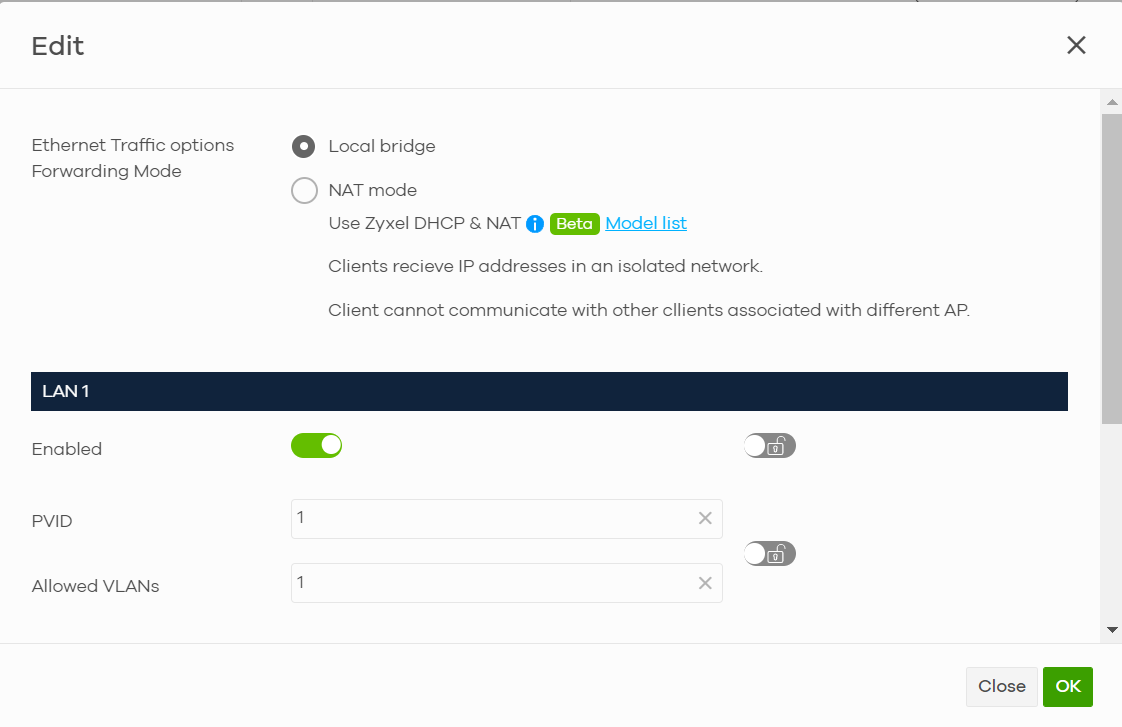Access Point
Overview
This chapter discusses the menus that you can use to monitor the Nebula-managed APs (Access Points) in your network and configure settings even before an AP is deployed and added to the site.
Nebula Device refers to Zyxel Hybrid APs (NAP / NWA / WAC / WAX Series) in this chapter. To view the list of Nebula Devices that can be managed through NCC, go to Help > Support tools > Device function table.
The following features in the Access Point menus apply to specific models only.
features/fields | Included Nebula Devices | location |
|---|---|---|
Ethernet Secure Tunnel Setting in Remote AP Setting | WAC500H | Click a Nebula Device entry in the Access Point > Monitor > Access Points screen to display individual Nebula Device statistics. See Access Points for more information. |
Wired stations | ||
WPA3 in Security options | NWA110AX, WAX510D, WAX650S | Click Access Point > Configure > SSID advanced settings. See SSID Advanced Settings for more information. |
Ethernet Traffic options Forwarding Mode | WAC500H | Click an entry in the Port setting table of the Access Point > Configure > AP & port settings screen to access the Edit – AP & port settings screen. See Edit Port Settings for more information. |
Nebula Smart Mesh
Nebula Smart Mesh, also called Smart Mesh or AP Smart Mesh, is a WiFi mesh solution for Nebula Devices. With Smart Mesh, you can have two or more Nebula Devices automatically create a mesh network within your home or office, ensuring there are no areas with a weak WiFi signal.
Nebula Smart Mesh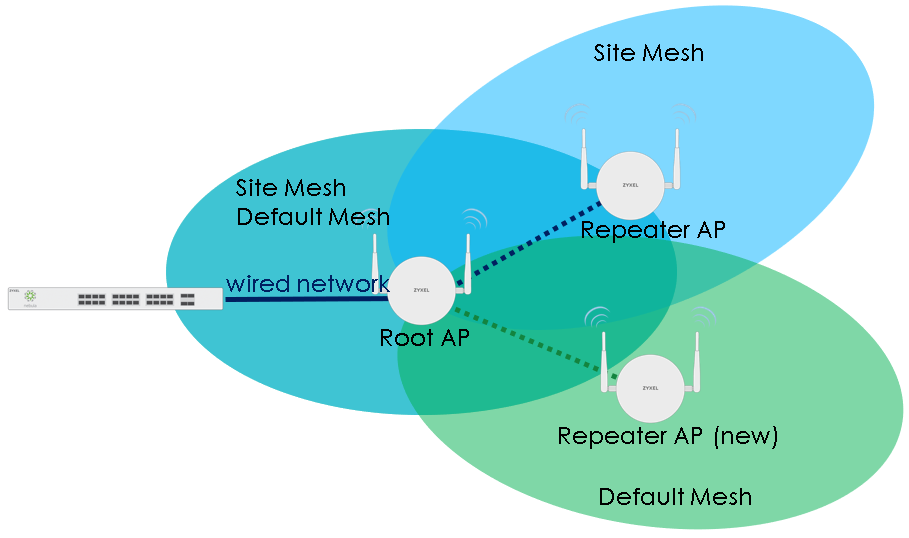

Smart Mesh assigns a role to each Nebula Device depending on its connection method.
• Root AP: A Nebula Device (mesh controller) that is connected to the network by Ethernet and can reach the gateway device.
• Repeater AP: A Nebula Device (mesh extender) that is connected to the network wirelessly, or that is connected to the network by Ethernet but cannot reach the gateway device.
The mesh extender rebroadcast the mesh controller’s SSID, and then relay WiFi traffic back to the gateway.
To create a Smart Mesh network, add two or more Nebula Devices to the same Nebula-managed site and ensure that each Nebula Device has Smart Mesh enabled. Then connect one or more Nebula Devices to your network’s gateway using an Ethernet cable, so that you have at least one mesh controller. Finally, place one or more non-wired Nebula Devices in areas where you want to extend WiFi coverage.
Smart Mesh Network Topology
After you add a Nebula Device to an NCC site and then turn it on, the new Nebula Device automatically connects to a mesh network called the default mesh. The Nebula Device then tries to connect to a mesh controller and contact NCC. After the Nebula Device successfully contacts NCC and joins the site, the Nebula Device stops using the default mesh and instead connects to other Nebula Devices in the site using a dedicated network called the site mesh.
Smart Mesh Wireless Hops
Each mesh extender tries to connect to the site gateway through a mesh controller. If a mesh extender cannot connect directly to a mesh controller, then the mesh extender relays its WiFi traffic through another mesh extender. Each time traffic passes through a WiFi connection in the mesh network, it counts as one hop.
Nebula Smart Mesh supports an unlimited number of hops. However, each hop in a mesh network reduces network throughput by up to half. Therefore, we recommend only allowing a maximum of two hops within your Smart Mesh network.
Nebula Smart Mesh Wireless Hops

Wireless Bridge
Wireless bridge is a Smart Mesh feature that allows two Nebula Devices to automatically connect two network segments together over a WiFi connection. This is useful when you want to extend your wired network to a new area, but it is difficult to run cables to that area.
To use wireless bridge, enable Wireless Bridge on two Nebula Devices in NCC. Then connect wired clients to one of the Nebula Device’s LAN port. These wired clients form a new network segment and are able to reach the site gateway through the Nebula Device’s WiFi connection.
Nebula Smart Mesh Wireless Bridge

Monitor
Use the Monitor menus to check Nebula Device information, client information, event log messages and summary report for Nebula Devices in the selected site.
Access Points
This screen allows you to view the detailed information about an Nebula Device in the selected site. Click Access point > Monitor > Access points to access this screen.
Access point > Monitor > Access points

The following table describes the labels in this screen.
Label | Description |
|---|---|
Access point | Select to view device information and connection status in the past two hours, day, week or month. |
Click this button to reload the data-related frames on this page. | |
Action | Perform an action on the selected Nebula Devices. |
Reboot | Select this to restart the Nebula Device. |
Upgrade | Select this to upgrade the firmware on the Nebula Device. |
Change PSK | Select this to generate a random Pre-Shared Key, or use a custom Pre-Shared Key. This allows a user to access the WiFi network through the Nebula Device. |
Tag | Select one or multiple Nebula Devices and click this button to create a new tag for the Nebula Devices or delete an existing tag. At the time of writing, there are two pre-defined tags. The LED tags have priority over the LED setting in the Site-Wide > General Setting screen. • LED_Off: this tag allows you to turn off the LEDs (except the locator LED) on the selected Nebula Devices. • LED_On: this tag allows you to have the LEDs stay lit after the selected Nebula Devices are ready. |
Move | Select one or multiple Nebula Devices and click this button to move the Nebula Devices to another site or remove the Nebula Devices from the current site. |
AP Role | Select one or multiple Nebula Devices and click this button to enable or disable the Remote AP feature. Remote Nebula Device enables the site’s Security Appliance to connect to the Nebula Device through a secure VPN tunnel. This allows you to set up VPN-enabled WiFi Nebula Devices in remote locations, such as in a branch office or at home. Clients connected to these Nebula Devices can securely access your network through the VPN tunnel. |
Search | Specify your desired filter criteria to filter the list of Nebula Devices. |
access points | This shows the number of Nebula Devices connected to the site network. |
Export | Click this button to save the access point list as a CSV or XML file to your computer. |
* | Click this to select all the rows in this table. |
Status | This shows the status of the Nebula Device. • Green: The Nebula Device is online and has no alerts. • Amber: The Nebula Device has alerts. • Red: The Nebula Device is offline. • Gray: The Nebula Device has been offline for 7 days or more. • For example, an alert is created and the status color is amber when the Nebula Device is transmitting data at 100 Mbps in full duplex mode or when the Nebula Device is in a Limited Power mode. |
Name | This shows the descriptive name of the Nebula Device. |
LAN IP | This shows the local (LAN) IP address of the Nebula Device. |
Remote AP | This shows whether the Remote Nebula Device function is Enabled or Disabled. |
2.4GHz | This shows the number of WiFi clients in the 2.4 GHz band. |
5GHz | This shows the number of WiFi clients in the 5 GHz band. |
6GHz | This shows the number of WiFi clients in the 6 GHz band. |
AP Role Capability | This displays whether the Nebula Device can act as a remote Nebula Device (Remote AP) or not (Standard AP). |
Public IP | This shows the global (WAN) IP address of the Nebula Device. |
Model | This shows the model number of the Nebula Device. |
Client | This shows how many clients are connected to the Nebula Device within the specified time period. |
Current client | This shows how many clients are currently connecting to the Nebula Device. |
MAC address | This shows the MAC address of the Nebula Device. |
Channel | This shows the channel ID the Nebula Device is using. |
Channel Utilization 2.4GHz | This shows the percentage of the 2.4 GHz channel ID usage. |
Channel Utilization 5GHz | This shows the percentage of the 5 GHz channel ID usage. |
Channel Utilization 6GHz | This shows the percentage of the 6 GHz channel ID usage. |
Usage | This shows the amount of data consumed by the Nebula Device’s clients. |
% Usage | This shows the percentage of the Nebula Device’s data usage. |
Description | This shows the user-specified description for the Nebula Device. |
Tag | This shows the user-specified tag for the Nebula Device. |
Serial number | This shows the serial number of the Nebula Device. |
Configuration status | This shows whether the configuration on the Nebula Device is up-to-date. |
Connectivity | This shows the access point connection status. The red time slot indicates the connection to the NCC is down, and the green time slot indicates the connection is up. Move the cursor over a time slot to see the actual date and time when an Nebula Device is connected or disconnected. |
Ethernet 1 | This shows the speed and duplex mode of the Ethernet connection on the Nebula Device’s up-link port. It shows Down if the Nebula Device is connected to a mesh controller wirelessly. |
Neighbor Info | This shows the LLDP information received on the up-link port. |
Production information | This shows the production information of the Nebula Device. |
Hop | This shows the hop count of the Nebula Device. For example, “1” means the Nebula Device is connected to a mesh controller directly. “2” means there is another mesh extender between this Nebula Device and the mesh controller. |
IP type | This shows whether the IP address was assigned automatically (DHCP), or manually (Static IP). |
Uplink AP | This shows the role and descriptive name of the Nebula Device to which this Nebula Device is connected wirelessly. When Smart Mesh is enabled and the mesh extender losses connection to the mesh controller, click Reconnect to re-establish connection. |
Uplink signal | Before the slash, this shows the signal strength the uplink Nebula Device (a mesh controller or a mesh extender) receives from this Nebula Device (in repeater mode). After the slash, this shows the signal strength this Nebula Device (in repeater mode) receives from the uplink access point. |
Uplink Tx/Rx rate | This is the maximum transmission/reception rate of the mesh controller or mesh extender to which the Nebula Device is connected. |
Wireless bridge | This shows whether wireless bridge is enabled on the Nebula Device. For more information about wireless bridge, see Wireless Bridge. |
Uplink | This shows whether the Nebula Device is connected to the gateway through a wired Ethernet connection or WiFi connection. |
Power mode | This shows the Nebula Device’s power status. Full – the Nebula Device receives power using a power adapter and/or through a PoE switch/injector using IEEE 802.3at PoE plus. The PoE device that supports IEEE 802.3at PoE Plus can supply power of up to 30W per Ethernet port. Limited – the Nebula Device receives power through a PoE switch/injector using IEEE 802.3af PoE even when it is also connected to a power source using a power adapter. The PoE device that supports IEEE 802.3af PoE can supply power of up to 15.4W per Ethernet port. When the Nebula Device’s power mode is Limited, the Nebula Device throughput decreases and has just one transmitting radio chain. It always shows Full if the Nebula Device does not support power detection. |
Firmware availability | This shows whether the firmware on the Nebula Device is Up to date, there is firmware update available for the Nebula Device (Upgrade available), or a specific version of firmware has been installed by Zyxel customer support (Locked). |
Firmware status | This shows whether the firmware installed on the Nebula Device is up-to-date. |
Firmware type | This shows Stable when the installed firmware may not have the latest features but has passed Zyxel internal and external testing. This shows Latest when the installed firmware is the most recent release with the latest features, improvements, and bug fixes. This shows General Availability when the installed firmware is a release before Latest, but is still undergoing Zyxel external testing. This shows Dedicated when the installed firmware is locked and Zyxel support is monitoring. Contact Zyxel customer support if you want to unlock the firmware in order to upgrade to a later one. This shows Beta when the installed firmware is a release version for testing the latest features and is still undergoing Zyxel internal and external testing. This shows N/A when the Nebula Device is offline and its firmware status is not available. |
Current version | This shows the firmware version currently installed on the Nebula Device. |
Remote AP VPN | This shows which VPN the Remote Nebula Device tunnel is configured to use. If Remote Nebula Device is disabled, this field shows Disconnected. |
Click this icon to display a greater or lesser number of configuration fields. For faster loading of data, select only the configuration fields listed that do NOT take a long time to fetch data. |
Access Point Details
Click a Nebula Device entry in the Access point > Monitor > Access points screen to display individual Nebula Device statistics.
Access point > Monitor > Access points: Details Part 1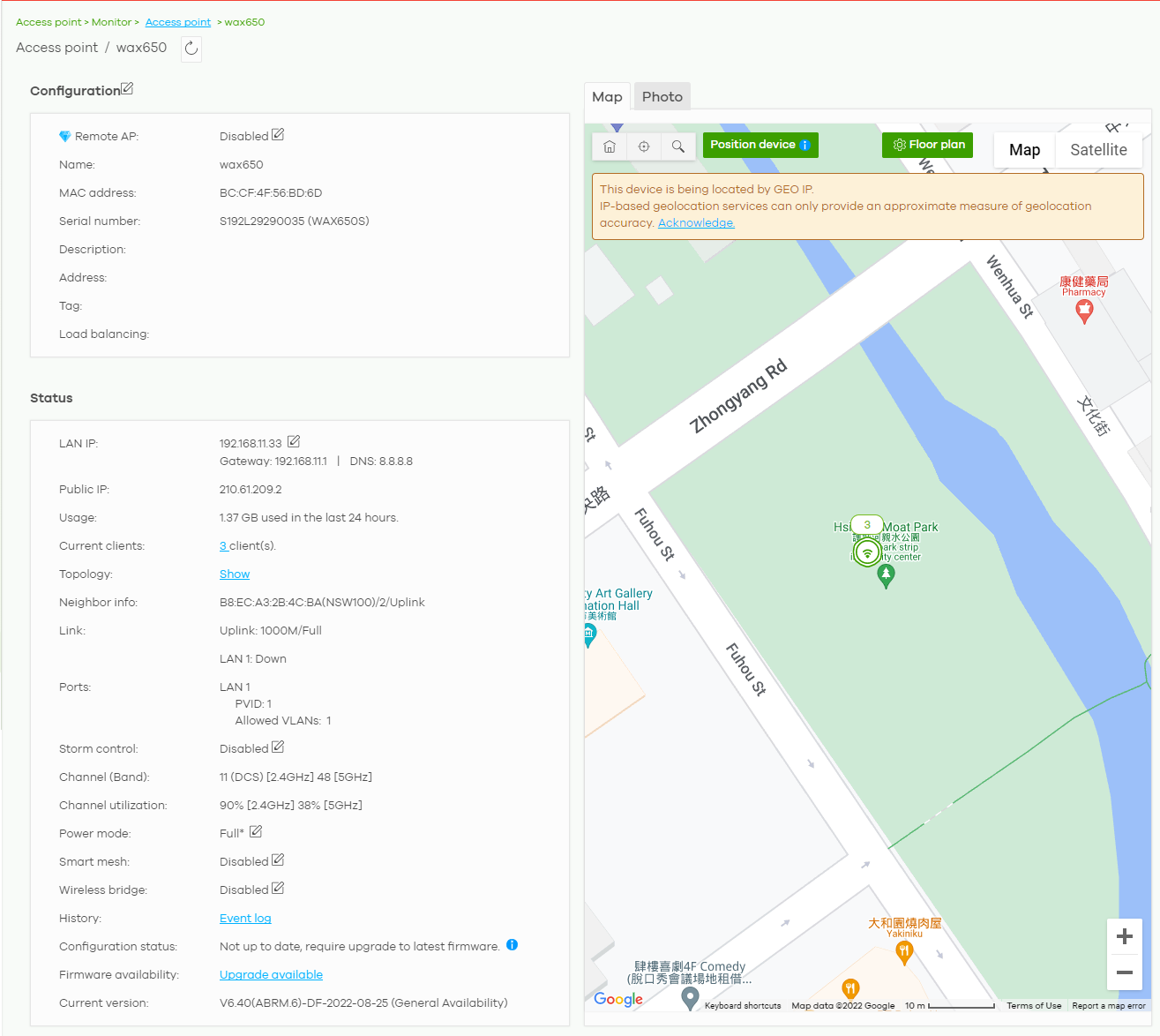

Access point > Monitor > Access points: Details Part 2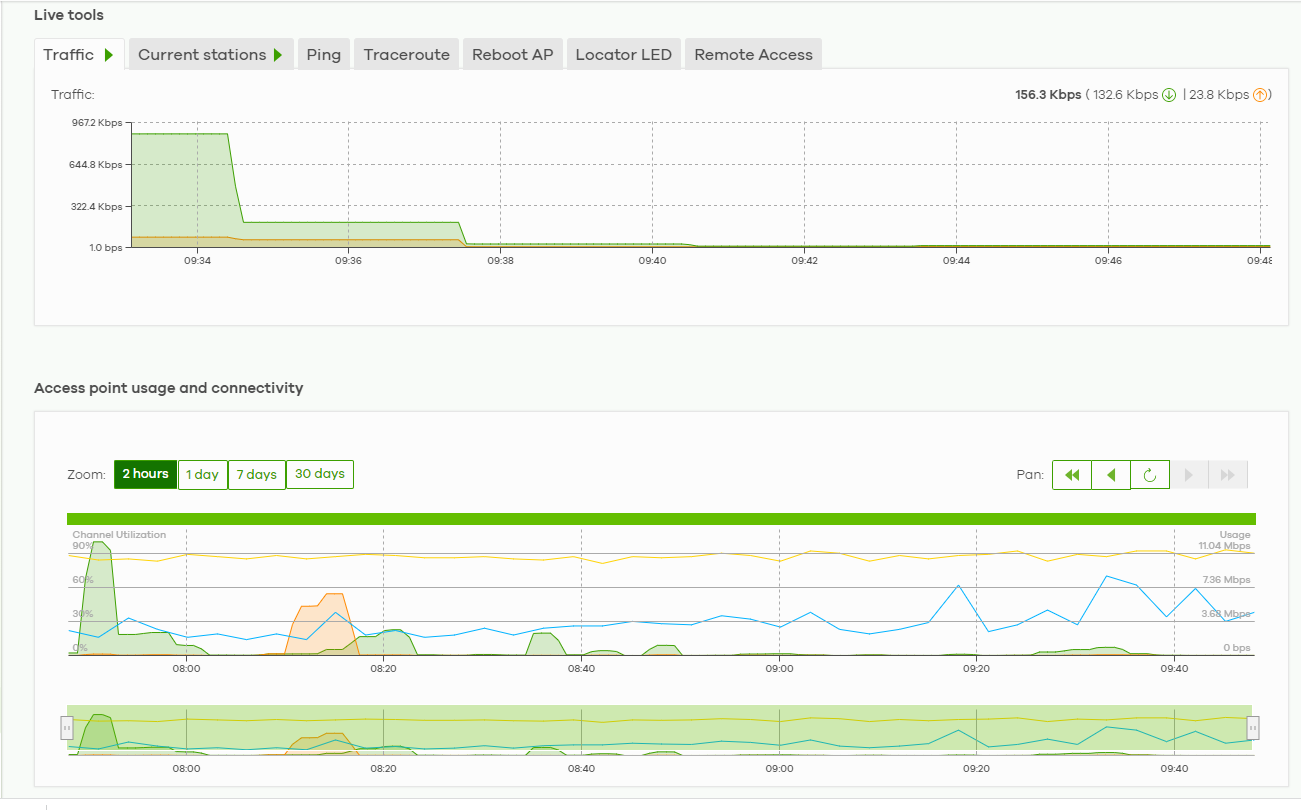

The following table describes the labels in this screen.
Label | Description |
|---|---|
Click this button to reload the data-related frames on this page. | |
Configuration Click the edit configuration icon to change the Nebula Device name, description, tags, load balancing, and address. You can also move the Nebula Device to another site or remove. | |
Remote AP | Click this to enable or disable the Remote AP feature. Remote AP enables the site’s Security Appliance to connect to the Nebula Device through a secure VPN tunnel. This allows you to set up VPN-enabled WiFi Nebula Devices in remote locations, such as in a branch office or at home. Clients connected to these Nebula Devices can securely access your network through the VPN tunnel. With the Remote AP feature (in the Secure WiFi license) the connection is from the Nebula Device to a managed access point using NVGRE (Network Virtualization using Generic Routing Encapsulation) over IPSec tunnel. This encapsulates and encrypts traffic from the remote access point to the Nebula Device. The clients connected to the remote access point do not need IPSec client software installed. At the time of writing, Ethernet Secure Tunnel Setting for Remote AP Setting is available for WAC500H only. Configure and enable up to two SSID(s) in Local SSID Setting. WiFi clients connected to these SSIDs are forwarded to the local network of the remote site. The Local SSID Setting are different from the SSIDs you configured in Access Point > Configure > SSID advanced settings. See SSID Advanced Settings for the description of the fields. Select from the available LAN or VLAN interface in Tunnel to gateway interface to enable it, and click Save. |
Name | This shows the descriptive name of the Nebula Device. |
MAC address | This shows the MAC address of the Nebula Device. |
Serial number | This shows the serial number of the Nebula Device. |
Description | This shows the user-specified description for the Nebula Device. |
Address | This shows the user-specified address for the Nebula Device. |
Tag | This shows the user-specified tag for the Nebula Device. |
Load balancing | This shows the load balancing group name that the Nebula Device belongs (up to two groups per access point). Nebula Devices in the same group should be within the proximity. This allows them to share the load. |
Status | |
LAN IP | This shows the local (LAN) IP address of the Nebula Device. It also shows the IP addresses of the gateway and DNS server. Click the edit icon to open a screen where you can change the IP addresses, VLAN ID number and tagging setting. |
Public IP | This shows the global (WAN) IP address of the Nebula Device. |
Usage | This shows the amount of data consumed by the clients. |
Current clients | This shows the number of clients which are currently connecting to the Nebula Device and its details. |
Topology | |
Neighbor info | This shows the LLDP information received on the up-link port. |
Link | This shows the speed and duplex mode of the Ethernet connection on the Nebula Device’s ports. It shows Uplink: Wireless if the access point is an mesh extender and connected to a mesh controller wirelessly. A warning icon displays when the Nebula Device is running at 100 Mbps or a lower speed. |
Ports | This is available only for the Nebula Device that has one or more than one Ethernet LAN port (except the uplink port). This shows the PVID of the LAN port and the ID number of VLANs to which the LAN port belongs. See AP & Port Settings for how to change the port’s VLAN settings. |
Storm control | Storm control limits the number of broadcast, multicast and destination lookup failure (DLF) packets received per second on the Nebula Device’s Ethernet ports. When the maximum number of allowable broadcast, multicast and/or DLF packets is reached per second, the subsequent packets are discarded. Enabling this feature reduces broadcast, multicast and/or DLF packets in your network. |
Channel (Band) | This shows the channel ID and WiFi frequency band currently being used by the Nebula Device. |
Channel utilization | This shows the percentage of the channel ID usage. |
Power mode | This shows Full when the Nebula Device receives power directly through a power outlet. This shows Full (Power by DC) when the Nebula Device receives power using a power adapter. This shows Full (Power by PoE) when the Nebula Device receives power through a PoE switch/injector using IEEE 802.3at PoE plus. The PoE device that supports IEEE 802.3at PoE Plus can supply power of up to 30W per Ethernet port. This shows Limited (Require 802.3bt power) when the Nebula Device receives power through a PoE switch/injector using IEEE 802.3bt PoE even when it is also connected to a power source using a power adapter. The PoE device that supports IEEE 802.3bt PoE can supply power of up to 71.3W per Ethernet port. This shows Limited (Require 802.3at power) when the Nebula Device receives power through a PoE switch/injector using IEEE 802.3at PoE even when it is also connected to a power source using a power adapter. The PoE device that supports IEEE 802.3at PoE can supply power of up to 15.4W per Ethernet port. This field is blank when the access point’s firmware is older than version 5.50 or (WAX650S / WAX510D firmware is older than version 6.00P4C0). Or when the access point is offline. Click the edit icon to open a screen where you can enable full power mode. |
Antenna | This displays the antenna orientation settings for the Nebula Device that comes with internal antennas and also has an antenna switch. |
Smart mesh | This shows whether Nebula Smart Mesh is enabled on the Nebula Device. For more information about Smart Mesh, see Nebula Smart Mesh. To view the list of Nebula Devices that support smart mesh, go to Help > Device function table. |
Edit | Edit the Nebula Device’s Smart Mesh settings. |
Enabled | Enable or disable Smart Mesh on the Nebula Device. This setting overrides the Smart Mesh settings configured for the Nebula Device’s site in NCC. |
Lock | When enabled, the Nebula Device’s local Smart Mesh settings overrides the Smart Mesh settings configured for the Nebula Device’s site in NCC. Example 1: If Smart Mesh is enabled for the site in NCC, you can disable Smart Mesh on the Nebula Device by setting Lock to on and Enabled to off. Example 2: If Smart Mesh is disabled for the site in NCC, you can enable Smart Mesh on the Nebula Device by setting Lock to on and Enabled to on. |
Band | This setting will apply to mesh extender. • Select Auto (high band preferred) to allow the mesh extender to select a higher radio band mesh controller. • Select 2.4 GHz to use the 2.4 GHz band for regular Internet surfing and downloading. • Select 5 GHz or 6 GHz to use the 5 or 6 GHz band for time sensitive traffic like high-definition video, music, and gaming. |
Downlink | When enabled, the mesh extender can provide downlink capability to another mesh extender. |
Manual uplink | When enabled, this allows you to select a mesh controller or mesh extender. |
Uplink auto failover | When enabled, an mesh extender that cannot connect to the selected mesh controller after 5 tries, will automatically connect to another mesh controller or mesh extender. |
select a AP | Select a mesh controller or mesh extender. |
Wireless bridge | This shows whether wireless bridge is enabled on the Nebula Device. For more information about wireless bridge, see Wireless Bridge. |
Edit | Edit the Nebula Device’s wireless bridge settings. |
Enabled | Enable or disable wireless bridge on the Nebula Device. |
Allowed VLANs | Enter the IDs of the VLANs that the Nebula Device will forward over the wireless bridge. By default, this field uses the VLANs allowed for LAN1 at Access point > Configure > AP & port settings. For details, see AP & Port Settings. |
History | Click Event log to go to the Access point > Monitor > Event log screen. |
Configuration status | This shows whether the configuration on the Nebula Device is up-to-date. |
Firmware availability | This shows whether the firmware on the Nebula Device is up-to-date or there is firmware update available for the Nebula Device. |
Current version | This shows the firmware version currently installed on the Nebula Device. |
Map | This shows the location of the Nebula Device on Google map (Map view or Satellite imagery view) or on a floor plan. Click Floor plan to display a list of existing floor plans. Each floor plan has a drawing that shows the rooms scaled and viewed from above. Drag-and-drop your Nebula Device directly on the Google map or click Position device to update the Nebula Device’s address (physical location). • Select GEO IP to use the public IP address of the Nebula Device. • Select Get my location from web browser to use the public IP address of the computer accessing the NCC portal. • Select Use the following address or coordinates to enter the complete address or coordinates of the Nebula Device. |
Photo | This shows the photo of the Nebula Device. Click Add to upload one or more photos. Click x to remove a photo. |
Live tools | |
Traffic | This shows the Nebula Device traffic statistics. |
Current stations | This shows the Nebula Device’s connected WiFi clients’ MAC address, SSID name, IPv4 Address, Signal strength, Security, Channel, Tx rate, Rx rate, Association time, and Capability. |
Ping | Enter the domain name or IP address of a computer that you want to perform ping from the Nebula Device in order to test a connection and click Ping. This can be used to determine if the Nebula Device and the computer are able to communicate with each other. |
Traceroute | Enter the domain name or IP address of a computer that you want to perform traceroute from the Nebula Device and click Run. This determines the path a packet takes to the specified computer. |
Reboot AP | Click the Reboot button to restart the Nebula Device. |
Locator LED | Enter a time interval between 1 and 60 minutes. The locator LED will blink for the number of minutes set here once you turn on the locator LED. Click the  button to turn on the locator feature, which shows the actual location of the Nebula Device between several devices in the network. button to turn on the locator feature, which shows the actual location of the Nebula Device between several devices in the network. |
Remote Access | This allows you to establish a remote connection to this Nebula Device by specifying the port number. Then click Establish. This feature is available to the organization owner, organization administrators with full privileges, and site administrators with full privileges. |
Wired stations | This shows the Nebula Device’s connected wired clients’ MAC address, IPv4 Address, Port number, and the VLAN ID assigned to the wired station. |
Access point usage and connectivity Move the cursor over the chart to see the transmission rate at a specific time. | |
Zoom | Select to view the statistics in the past 2 hours, day, week, or month. |
Pan | Click to move backward or forward by one day or week. |
Clients
This screen allows you to view the connection status and detailed information about clients connected to an Nebula Device in the selected site. Click Access Point > Monitor > Clients to access this screen.
Access Point > Monitor > Clients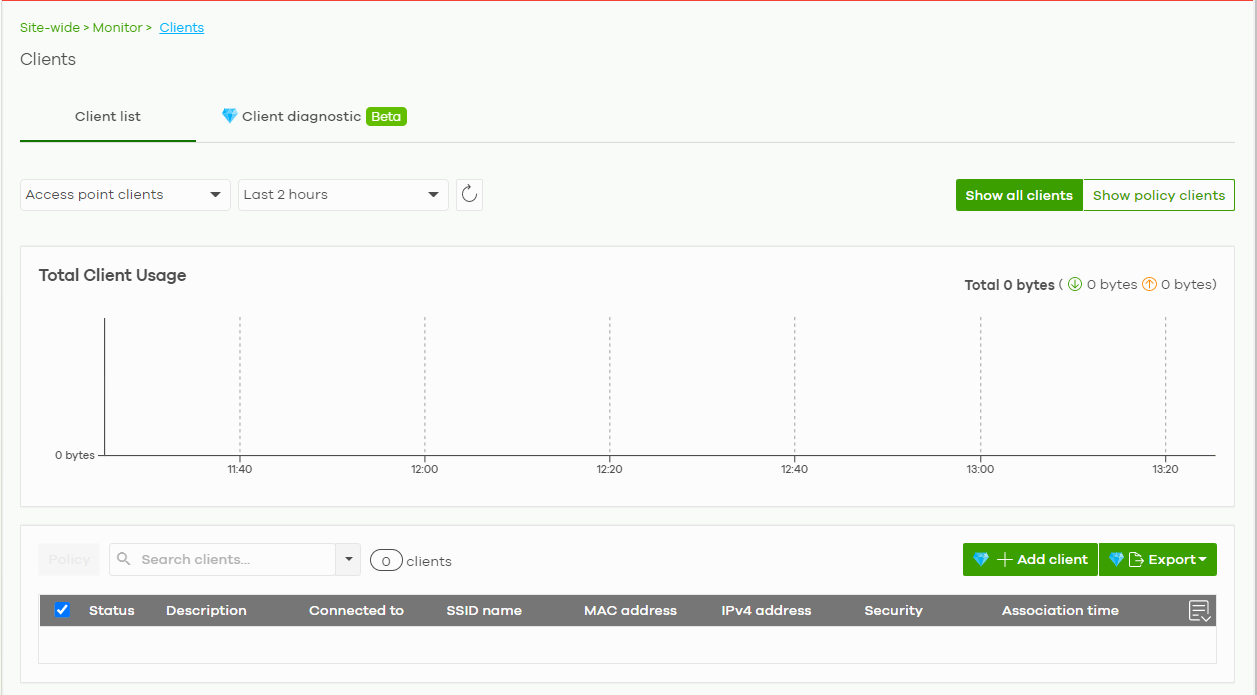

The following table describes the labels in this screen.
Label | Description |
|---|---|
Clients | Select to view the connected device information and connection status in the past two hours, day, week or month. • Select Show all clients to show clients that have been online during the selected time period. • Select Show policy clients to show clients that have a white-listed or blocked policy applied to them, regardless of when they were last online. The client’s usage data is calculated according to the selected time period. |
Click this button to reload the data-related frames on this page. | |
y-axis | The y-axis shows the transmission speed of data sent or received by the client in kilobits per second (Kbps). |
x-axis | The x-axis shows the time period over which the traffic flow occurred. |
Policy | Select the clients from the table below, and then choose the security policy that you want to apply to the selected clients. Choose Normal to apply the captive portal authentication to the selected clients. To allow the selected clients to bypass captive portal authentication, choose Whitelisted. Choose Blocked when the selected clients fails the captive portal authentication. Choose To specific SSID to selectively apply captive portal authentication to specific SSIDs. Then, click Apply policy. 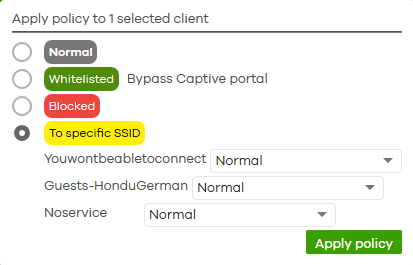 |
Search | Specify your desired filter criteria to filter the list of clients. |
Clients | This shows the number of clients connected to an Nebula Device in the site network. |
Add client | Click this button to open a window where you can specify a client’s name and MAC address to apply a policy before it is connected to the Nebula Device’s network. |
Export | Click this button to save the client list as a CSV or XML file to your computer. |
Status | This shows whether the client is online (green) or offline (red), and whether the client is wired or WiFi. |
Description | This shows the descriptive name of the client. Click the name to display the individual client statistics. See Client Details. |
Connected to | This shows the name of the Nebula Device to which the client is connected. Click the name to display the individual Nebula Device statistics. See Access Point Details. |
SSID name | This shows the name of the Nebula Device’s WiFi network to which the client is connected. |
MAC address | This shows the MAC address of the client. |
IPv4 address | This shows the IP address of the client. |
Channel | This shows the channel ID the client is using. |
Band | This shows the WiFi frequency band currently being used by the client. |
Signal strength | This shows the RSSI (Received Signal Strength Indicator) of the client’s WiFi connection, and an icon showing the signal strength. Icon default thresholds: • Green/5 blocks: signal is greater than –67 dBm, strong signal • Amber/4 blocks: signal –67 to –73 dBm, average signal • Amber/3 blocks: signal –74 to –80 dBm, below average signal • Red/2 blocks: signal is less than –80 dBm, weak signal |
Security | This shows which secure encryption method is being used by the client to connect to the Nebula Device. |
Tx Rate | This shows maximum transmission rate of the client. |
Rx Rate | This shows maximum reception rate of the client. |
Download | This shows the amount of data received by the client since it last connected. |
Upload | This shows the amount of data transmitted from the client since it last connected. |
Usage | This shows the amount of data consumed by the access point (upload + download) since it last connected. |
Association time | This shows the date and time the client associated with the Nebula Device. |
First seen | This shows the first date and time the client was discovered. |
Last seen | This shows the last date and time the client was discovered. |
Capability | This shows the WiFi standards supported by the client or the supported standards currently being used by the client. |
Manufacturer | This shows the manufacturer of the client device. |
Authentication | This shows the authentication method used by the client to access the network. This shows Unauthorized if the captive portal page displays but the client has not proceeded with the authentication process. The field is blank if web authentication is disabled. |
User | This shows the user account information used to log into the NCC through captive portal, using Facebook login or 802.1x with Nebula cloud authentication or a RADIUS server. This field is blank if the user logs in through Facebook WiFi or web authentication is disabled. |
OS | This shows the operating system running on the client device. |
Policy | This shows the security policy applied to the client. |
VLAN | This shows the ID number of the VLAN to which the client belongs. |
Note | This shows additional information for the client. |
Click this icon to display a greater or lesser number of configuration fields. |
Client Details
Click a client entry in the Access Point > Monitor > Clients screen to display individual client statistics.
Access Point > Monitor > Clients: Client Details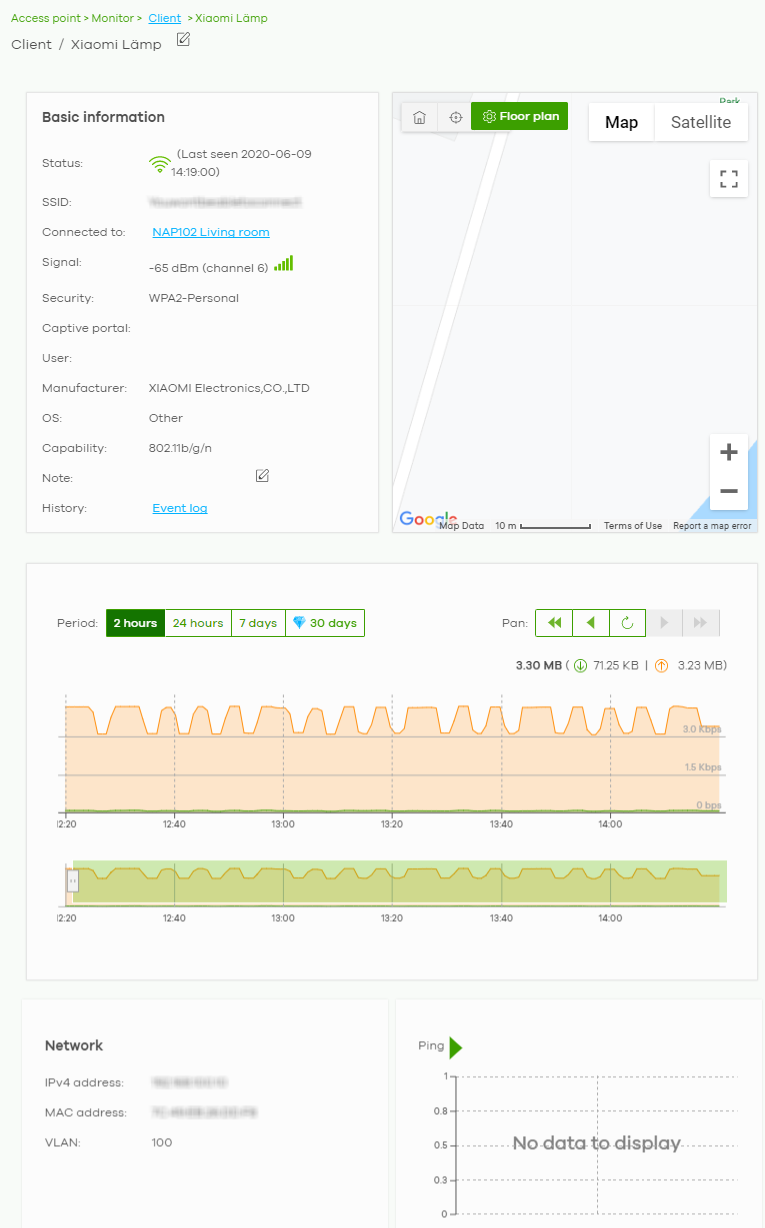

The following table describes the labels in this screen.
Label | Description |
|---|---|
Status | This shows whether the client is online (green), or goes offline (red). It also shows the last date and time the client was discovered. |
SSID | This shows the name of the Nebula Device’s WiFi network to which the client is connected. |
Connected to | This shows the name of the Nebula Device to which the client is connected. Click the name to display the individual Nebula Device statistics. See Access Point Details. |
Signal | This shows the RSSI (Received Signal Strength Indicator) of the client’s WiFi connection, and an icon showing the signal strength. Icon default thresholds: • Green/5 blocks: signal is greater than –67 dBm, strong signal • Amber/4 blocks: signal –67 to –73 dBm, average signal • Amber/3 blocks: signal –74 to –80 dBm, below average signal Red/2 blocks: signal is less than –80 dBm, weak signal |
Security | This shows the encryption method used to connect to the Nebula Device. |
Captive portal | This shows the web authentication method used by the client to access the network. |
User | This shows the number of users currently connected to the network through the client device. |
Manufacturer | This shows the manufacturer of the client device connected to the Nebula Device. |
OS | This shows the operating system running on the client device, if known. |
Capability | This shows the WiFi standards supported by the client or the supported standards currently being used by the client. |
Note | This shows additional information for the client. Click the edit icon to change it. |
History | Click Event log to go to the Access Point > Monitor > Event log screen. |
Map | This shows the location of the client on the Google map. |
Period | Select to view the statistics in the past two hours, day, week or month. |
Pan | Click to move backward or forward by two hours or one day. |
y-axis | The y-axis shows the transmission speed of data sent or received by the client in kilobits per second (Kbps). |
x-axis | The x-axis shows the time period over which the traffic flow occurred. |
Network | |
IPv4 address | This shows the IP address of the client. |
MAC address | This shows the MAC address of the client. If you applied a security policy to a client using the Add client button in the Access Point > Monitor > Clients screen, and the client has never been connected to the Nebula Device’s network, an edit icon appears allowing you to modify the client’s MAC address, |
VLAN | This shows the ID number of the VLAN to which the client belongs. |
Ping | Click the button to ping the client’s IP address from the Nebula Device to test connectivity. |
Loss rate | This shows the rate of packet loss when you perform ping. |
Average latency | This shows the average latency in ms when you perform ping. |
Event Log
Use this screen to view WiFi Nebula Device log messages. You can enter the Nebula Device name or a key word, select one or multiple event types, or specify a date/time or even a time range to display only the log messages related to it.
Click Access Point > Monitor > Event Log to access this screen.
Access Point > Monitor > Event log

Wireless Health
This screen lets you monitor the health of WiFi networks for your Nebula Devices and connected WiFi clients.
You can improve WiFi network performance by doing the following:
• Enable DCS (Dynamic Channel Selection) to select a radio channel with least interference
• Enable client steering to use a stronger WiFi signal
• Change channel bandwidth to reduce radio interference from other WiFi devices
Click Access Point > Monitor > Wireless Health to access this screen.
Access Point > Monitor > Wireless Health

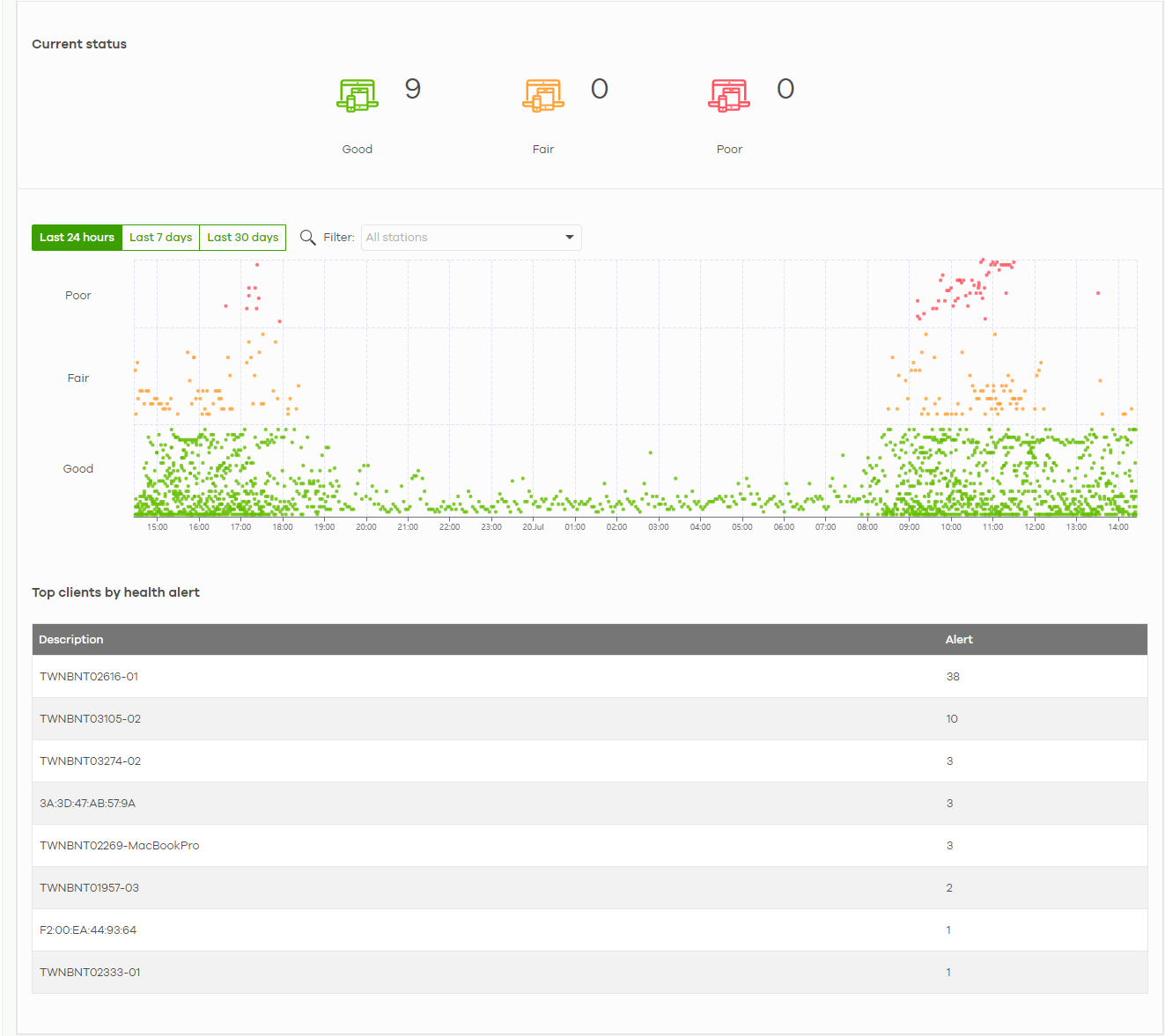
The following table describes the labels in this screen.
Label | Description |
|---|---|
Auto optimization action | |
6G radio | Select ON to enable and specify how the Nebula Device improves the WiFi network performance. Otherwise, select OFF to disable it. • Adaptive channel width – select this option to have the Nebula Device change the channel bandwidth from 160 MHz to 80 MHz to reduce the radio interference with other WiFi devices. If adaptive channel width does not improve WiFi performance then the Nebula Device also performs Dynamic Channel Selection (DCS). • DCS (Dynamic Channel Selection) – select this option to have the Nebula Device scan and choose a radio channel that has least interference. |
5G radio | Select ON to enable and specify how the Nebula Device improves the WiFi network performance. Otherwise, select OFF to disable it. • Adaptive channel width – select this option to have the Nebula Device change the channel bandwidth from 80 MHz to 20 MHz to reduce the radio interference with other WiFi devices. If adaptive channel width does not improve WiFi performance then the Nebula Device also performs Dynamic Channel Selection (DCS). • DCS (Dynamic Channel Selection) – select this option to have the Nebula Device scan and choose a radio channel that has least interference. |
2.4G radio | Select ON to enable and specify how the Nebula Device improves the WiFi network performance. Otherwise, select OFF to disable it. • DCS (Dynamic Channel Selection) – select this option to have the Nebula Device scan and choose a radio channel that has least interference. |
Client | Select ON to have the Nebula Device try to steer the WiFi clients in poor health to a Nebula Device or SSID with a strong signal. Client steering to improve the signal strength is done every 30 minutes. Otherwise, select OFF to disable steering. |
Optimization aggressiveness | High, Standard and Low stand for different traffic rate threshold levels. The level you select here decides when the Nebula Device takes action to improve the access point’s WiFi network performance. The Nebula Device will postpone the actions implemented on access points until your network is less busy if the threshold is exceeded. Select a suitable traffic rate threshold level for your network. High: Select this if you want the Nebula Device to postpone the action set when the access point network traffic is heavy. Standard: Select this if you want the Nebula Device to postpone the action set when the access point network traffic is medium. Low: Select this if you want the Nebula Device to postpone the action set when the access point network traffic is low. |
AP wireless health overview Move the cursor over the information icon to view the supported Nebula Device model list. | |
Current status | This shows the number of supported Nebula Devices that are currently online, using the specified frequency band that are in Good, Fair or Poor wireless health threshold as detected by Nebula. |
y-axis | The y-axis represents the state of wireless health. |
x-axis | The x-axis shows the time period over which the Nebula Device health state is recorded. |
Top APs by health alert | |
Name | This shows the descriptive name of the Nebula Device. |
Model | This shows the model number of the Nebula Device. |
Alert | This shows how many times the Nebula Device is in a poor state of wireless health. The NCC generates a log when the Nebula Device is in poor wireless health. You can view the log messages in the Access Point > Monitor > Event Log screen. |
Clients wireless health overview | |
Current status | This shows the number of connected WiFi clients that are currently online, using the specified frequency band and in Good, Fair or Poor wireless health threshold as detected by Nebula. |
Client health | Select to view the health of all WiFi clients which are connected to the supported Nebula Devices using the 6 GHz, 5 GHz or 2.4 GHz band. You can select to view the health report for the past day, week or month, as well as filter the WiFi station to view. |
y-axis | The y-axis represents the state of wireless health. |
x-axis | The x-axis shows the time period over which the client health state is recorded. |
Top clients by health alert | |
Description | This shows the descriptive name of the client. |
Alert | This shows how many times the client is in a poor state of wireless health. The NCC generates a log when the client is in poor wireless health. You can view the log messages in the Access Point > Monitor > Event Log screen. |
Summary Report
This screen displays network statistics for Nebula Devices of the selected site, such as bandwidth usage, top clients and/or top SSIDs.
Click Access Point > Monitor > Summary Report to access this screen.
Access Point > Monitor > Summary Report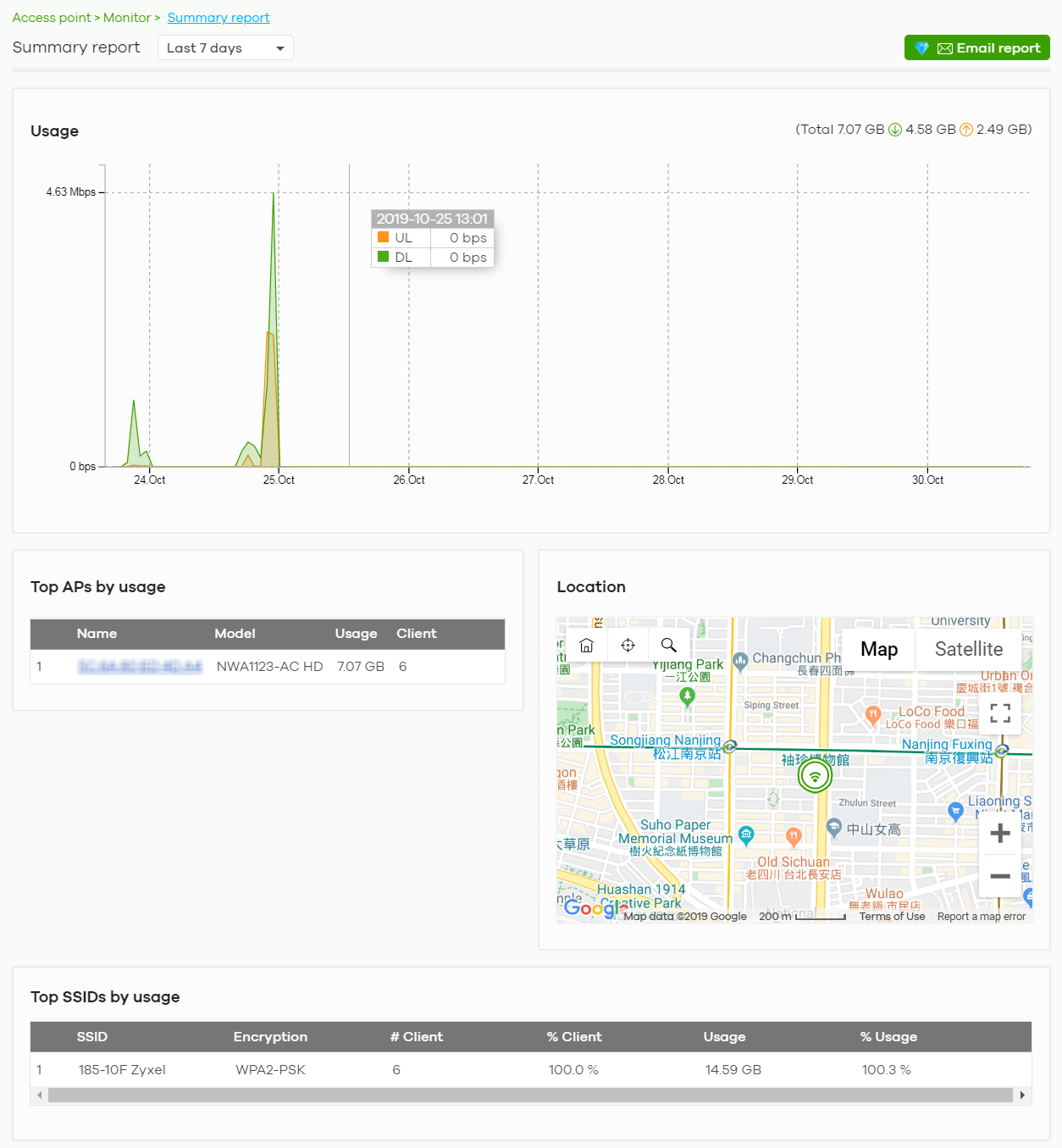


The following table describes the labels in this screen.
Label | Description |
|---|---|
Summary report | Select to view the report for the past day, week or month. Alternatively, select Custom range... to specify a time period the report will span. You can also select the number of results you want to view in a table. |
Email report | Click this button to send summary reports by email, change the report logo and set email schedules. |
Usage | |
y-axis | The y-axis shows the transmission speed of data sent on this port in megabits per second (Mbps). |
x-axis | The x-axis shows the time period over which the traffic flow occurred. |
Top APs by usage | |
# | This shows the ranking of the Nebula Device. |
Name | This shows the descriptive name of the Nebula Device. |
Model | This shows the model number of the Nebula Device. |
Usage | This shows the amount of data transmitted or received by the Nebula Device. |
Client | This shows how many clients are currently connecting to the Nebula Device. |
Location This shows the location of the Nebula access points on the map. | |
Top SSIDs by usage | |
# | This shows the ranking of the SSID. |
SSID | This shows the SSID network name. |
Encryption | This shows the encryption method used by the SSID network. |
# Client | This shows how many WiFi clients are connecting to this SSID. |
% Client | This shows what percentage of associated WiFi clients are connecting to this SSID. |
Usage | This shows the total amount of data transmitted or received by clients connecting to this SSID. |
% Usage | This shows the percentage of usage for the clients connecting to this SSID. |
Clients per day | |
y-axis | The y-axis represents the number of clients. |
x-axis | The x-axis represents the date. |
Top clients by usage | |
# | This shows the ranking of the client. |
Description | This shows the descriptive name or MAC address of the client. |
Usage | This shows the total amount of data transmitted and received by the client. |
% Usage | This shows the percentage of usage for the client. |
Top operating systems by usage | |
# | This shows the ranking of the operating system. |
OS | This shows the operating system of the client device. |
# Client | This shows how many client devices use this operating system. |
% Client | This shows the percentage of top client devices which use this operating system. |
# Usage | This shows the amount of data consumed by the client device on which this operating system is running. |
% Usage | This shows the percentage of usage for top client devices which use this operating system. |
Top client device manufacturers by usage | |
# | This shows the ranking of the manufacturer. |
Manufacturer | This shows the manufacturer name of the client device. |
# Client | This shows how many client devices are made by the manufacturer. |
% Client | This shows the percentage of top client devices which are made by the manufacturer. |
# Usage | This shows the amount of data consumed by the client device. |
% Usage | This shows the percentage of usage for the client device. |
Configure
Use the Configure menus to set the WiFi security settings for Nebula Devices of the selected site.
SSID Settings
This screen allows you to configure up to eight different SSID profiles for your Nebula Devices. An SSID, or Service Set IDentifier, is basically the name of the WiFi network to which a WiFi client can connect. The SSID appears as readable text to any device capable of scanning for WiFi frequencies (such as the WiFi adapter in a laptop), and is displayed as the WiFi network name when a person makes a connection to it.
Click Access Point > Configure > SSID settings to access this screen.
Access Point > Configure > SSID settings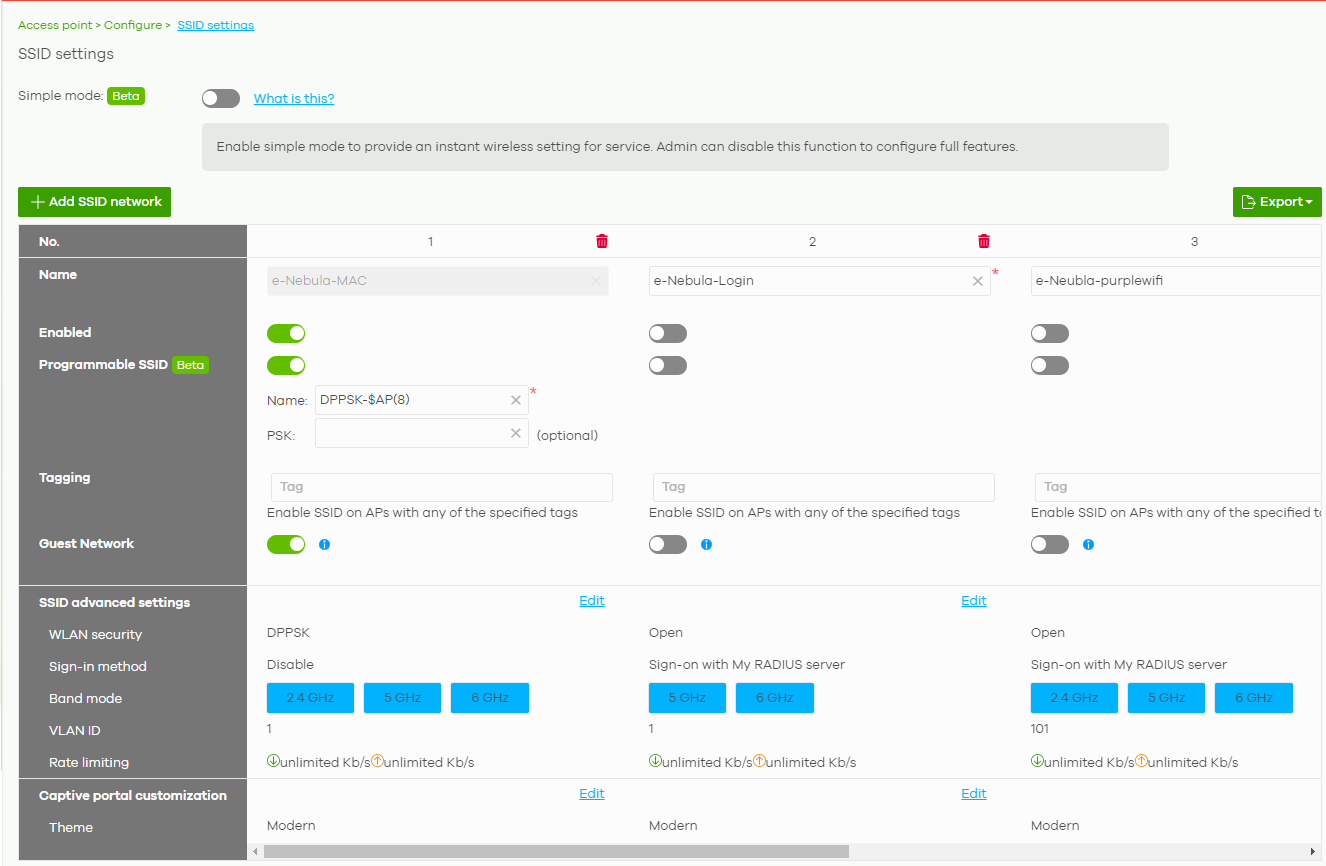

The following table describes the labels in this screen.
Label | Description |
|---|---|
Simple Mode | Select On to enable Simple Mode. Simple Mode allows you to create SSID profiles by only specifying an SSID name and optional password. NCC sets all other WiFi settings to default. |
+ Add SSID network | Click this button to configure up to eight different SSID profiles for your Nebula Devices |
No. | This shows the index number of this profile. |
delete | Click this icon to remove the SSID profile. |
Name | This shows the SSID name for this profile. Click the text box and enter a new SSID if you want to change it. |
Enabled | Click to turn on or off this profile. |
Programmable SSID | Select On to have each Nebula Device that uses this SSID generate a unique SSID name and pre-shared key (PSK) based on the Nebula Device’s model name, serial number, or MAC address. For example, a hotel can install a Nebula Device in each room and then have each Nebula Device broadcast a unique SSID based on the room number: FreeWiFi_Room1, FreeWiFi_Room2, FreeWiFi_Room3, and so on. |
Name | Name: Enter a programmable SSID name in the format PREFIX+VALUE(X). This name overrides the original SSID name. • PREFIX: Optional prefix to add to the SSID, for example “FreeWiFi_”. To use “$” in the SSID name, enter “$$” • VALUE: Specify a Nebula Device value to use to generate the SSID name. Use one of the following: $AP = Nebula Device device name. $MAC = Nebula Device MAC address. $SN = Nebula Device serial number. • X: Specify how many characters of the Nebula Device value to use in the SSID. A positive number means the first X characters, and a negative number means the last X characters. Example: FreeWiFi_Room$AP(–3) generates an SSID called “FreeWiFi_Room” + the last three characters of the access point device name. |
PSK | PSK: Enter an optional programmable PSK in the format GENTYPE(Y). • GENTYPE: Specify how the Nebula Device will generate a random PSK. $GENMIX = The Nebula Device generates a mix of random letters and numbers. $GENNUM = The Nebula Device generates a mix of random numbers only. $AP = Nebula Device device name. $MAC = Nebula Device MAC address. $SN = Nebula Device serial number. Y = Specify the length of the PSD. The minimum length is 8. Example 1: $GENNUM(10) generates a unique 10-character PSK for this SSID, consisting only of numbers. Example 2: $MAC(-5)$SN(-5) uses the MAC address’s last 5 characters and the serial number’s last 5 characters (for example, 8E3AE02451). Example 3: ZYXEL-$GENMIX(4) appends the fixed characters ‘ZYXEL’ and generates a unique 4-character mix of random letters and numbers (for example, ZYXEL-3c4d). |
Tagging | Enter or select the tags you created for Nebula Devices in the Access Point > Monitor > Access Points screen. The SSID profile will only be applied to Nebula Devices with the specified tag. If you leave this field blank, this SSID profile will be applied to all Nebula Devices in the site. |
Guest Network | Select On to set this WiFi network as a guest network. Layer 2 isolation and intra-BSS blocking are automatically enabled on the SSID. WiFi clients connecting to this SSID can access the Internet through the Nebula Device but cannot directly connect to the LAN or the WiFi clients in the same SSID or any other SSIDs. 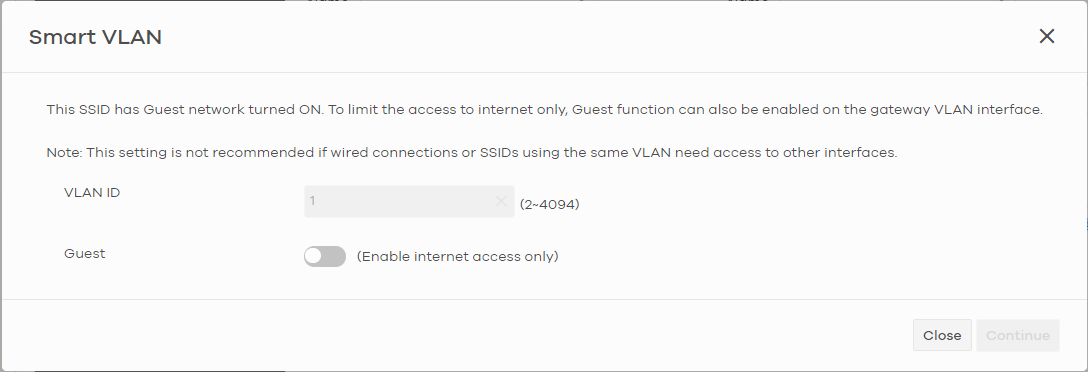 |
SSID advanced settings | |
Edit | Click this button to go to the Authentication screen and configure the advanced settings, such as SSID availability, WiFi security, L2 isolation, intra-BSS traffic blocking and walled garden settings. See SSID Advanced Settings. |
WLAN security | This shows the encryption method used in this profile. |
Sign-in method | This shows the authentication method used in this profile. |
Band mode | This shows whether the SSID use either 2.4 GHz band, 5 GHz band, or the 6 GHz band. |
VLAN ID | This shows the ID number of the VLAN to which the SSID belongs. |
Rate limiting | This shows the maximum incoming/outgoing transmission data rate (in Kbps) on a per-station basis. |
Captive portal customization | |
Edit | Click this button to go to the Captive Portal screen and configure the captive portal settings. See Captive Portal Customization. |
Theme | If captive portal is enabled, this shows the name of the captive portal page used in this profile. |
SSID Advanced Settings
Use this screen to configure the WiFi security, L2 isolation, intra-BSS traffic blocking and walled garden settings for the SSID profiles.
Click Access Point > Configure > SSID advanced settings to access this screen.
Access Point > Configure > SSID advanced settings Part 1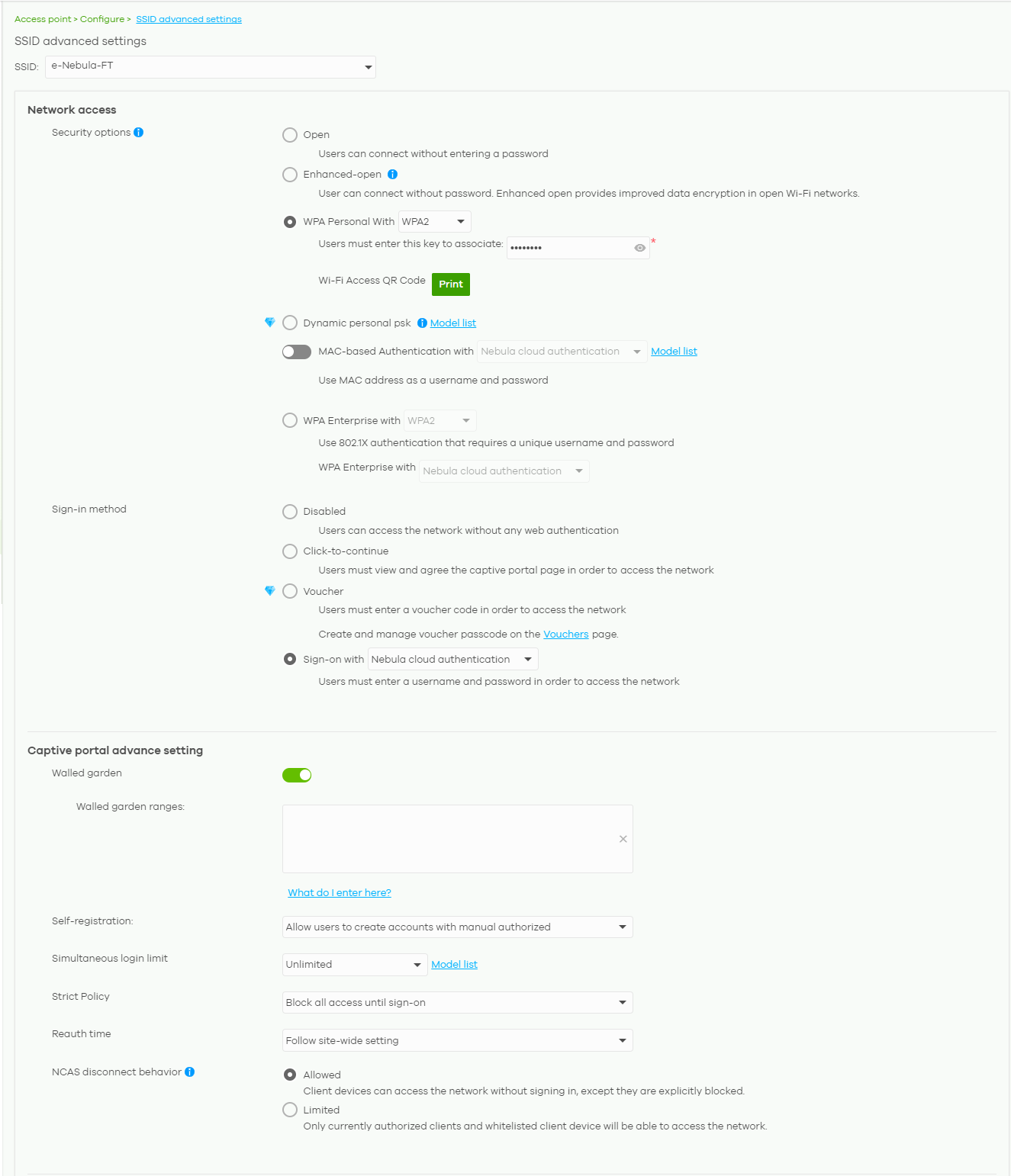

Access Point > Configure > SSID advanced settings Part 2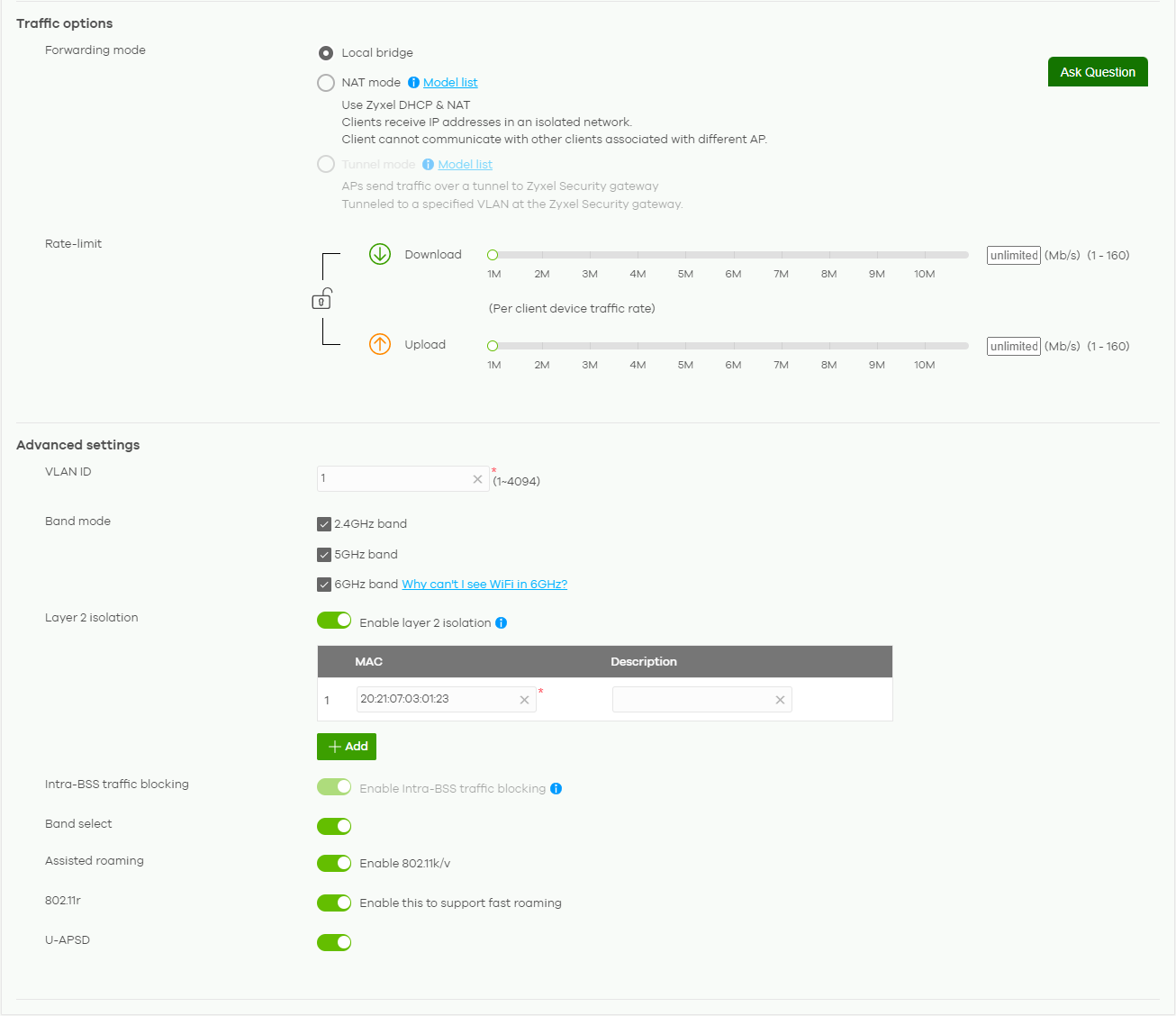

The following table describes the labels in this screen.
Label | Description |
|---|---|
SSID advanced settings | Select the SSID profile to which the settings you configure here is applied. |
Network access | |
Security options | Select Open to allow any client to associate this network without any data encryption or authentication. Select Enhanced-open to allow any client to associate this network without any password but with improved data encryption. Upon selecting Enhanced-open or WPA Personal With WPA3, transition mode generates two VAP so devices that do not support Enhanced-Open/WPA Personal With WPA3 can connect using Open/WPA Personal With WPA2 network. This is always on at the time of writing. Select WPA Personal With (WPA1/WPA2/WPA3) and enter a pre-shared key from 8 to 64 case-sensitive keyboard characters to enable WPA1/2/3-PSK data encryption. Upon selecting WPA Personal With WPA3, Nebula Devices that do not support it will revert to WPA2. • Turn on 802.11r to enable IEEE 802.11r fast roaming on the access point. 802.11r fast roaming reduces the delay when the clients switch from one Nebula Device to another by allowing security keys to be stored on all Nebula Devices in a network. Information from the original association is passed to the new Nebula Device when the client roams. The client does not need to perform the whole 802.1x authentication process. Click Print to display the QR code that includes the password for quick access. You can save the QR code as PDF. Select Dynamic personal psk to have every user connect to the SSID using a unique pre-shared key (PSK) that is linked to their user account. This allows you to revoke a user’s WiFi network access by disabling their account. After enabling this option, you must create one or more DPPSK users in the site or organization at Configure > Cloud authentication > Account Type > DPPSK. • For details on creating a site DPPSK user, see Create/Update User Account. • For details on creating organization DPPSK users, see Cloud Authentication. Turn on MAC-based Authentication with to authenticate WiFi clients by their MAC addresses together with My RADIUS server to use an external RADIUS server. Or select Nebula cloud authentication to use the NCC for MAC authentication. Select WPA-Enterprise with to enable 802.1X secure authentication. You can select My RADIUS server to use an external RADIUS server or select Nebula cloud authentication to use the NCC for 802.1X authentication. • Turn on 802.11r to enable IEEE 802.11r fast roaming on the Nebula Device. 802.11r fast roaming reduces the delay when the clients switch from one Nebula Device to another by allowing security keys to be stored on all Nebula Devices in a network. Information from the original association is passed to the new Nebula Device when the client roams. The client does not need to perform the whole 802.1x authentication process. • Select Two-Factor Authentication to require that the user log in using both their password and a Google Authenticator code. To log in, users must have Two-Factor Authentication enabled on their account and have setup Google Authenticator on their mobile device. Select Enable on RAP only to only require Two-Factor Authentication when accessing the network through a remote access point (RAP). |
Sign-in method | Select Disabled to turn off web authentication. Select Click-to-continue to block network traffic until a client agrees to the policy of user agreement. Select Voucher to require that a user logs in with a voucher code. For details on vouchers, see Vouchers. Select Sign-on with and: • select Nebula cloud authentication to block network traffic until a client authenticates with the NCC through the specifically designated web portal page. • select My RADIUS server to block network traffic until a client authenticates with an external RADIUS server through the specifically designated web portal page. Enable MAC authentication fallback when both RADIUS-based MAC authentication and web authentication are implemented. Scenario 1: When MAC authentication fails. A WiFi client tries to connect to the WiFi network using MAC authentication (RADIUS server). If MAC authentication fails, he will fall back to web authentication. The WiFi client needs to provide a user name and password for web authentication. Scenario 2: When MAC authentication is successful. A WiFi client tries to connect to the WiFi network and passes MAC authentication. Web authentication is then skipped. • select Facebook to block network traffic until a client authenticates with the NCC using Facebook Login. Facebook Login is a secure and quick way for users to log into your app or website using their existing Facebook accounts. If you get the App ID for your app at the Facebook developers site, you can enter your Facebook app ID to obtain more information about your users using Facebook Analytics, such as user activity, age, gender, and so on. • select Facebook Wi-Fi to let users check in to a business on Facebook for free Internet access after connecting to the Nebula Device’s WiFi network. Users then have the option to like the Facebook fan page. You should already have set up a Facebook fan page associated with the business location. Click here to open the Facebook WiFi configuration screen in a new window, where you can select the Facebook Page associated with your location and configure bypass mode and session length. |
Sign-in method (continued) |  |
RADIUS server | This field is available only when you select to use the following: • MAC-based Authentication with My RADIUS server or WPA2-Enterprise with My RADIUS server in the WLAN security field, or • when you select Sign-on with My RADIUS server in the Sign-in method field. Click Add to specify the IP address/domain name, port number, and shared secret password of the RADIUS server to be used for authentication. |
NAS Identifier | If the RADIUS server requires the Nebula Device to provide the Network Access Server identifier attribute with a specific value, enter it here. |
RADIUS accounting | This field is available only when you select to use WPA2-Enterprise with My RADIUS server in the WLAN security field, or when you select Sign-on with My RADIUS server in the Sign-in method field. Select RADIUS accounting enabled to enable user accounting through an external RADIUS server. Select RADIUS accounting disabled to disable user accounting through an external RADIUS server. |
RADIUS accounting servers | If you select RADIUS accounting enabled, click Add to specify the IP address, port number and shared secret password of the RADIUS server to be used for accounting. |
Captive portal advance setting | |
Walled garden | Select On to enable Walled garden. |
Walled garden ranges | This field is not configurable if you set Sign-in method to Disable. With a walled garden, you can define one or more web site addresses that all users can access without logging in. These can be used for advertisements for example. Select to turn on or off the walled garden feature. Specify walled garden web site links, which use a (wildcard) domain name or an IP address for web sites that all users are allowed to access without logging in. |
Self-registration | This field is available only when you set Sign-in method to Sign-on with Nebula Cloud authentication. Select Allow users to create accounts with auto authorized or Allow users to create accounts with manual authorized to display a link in the captive portal login page. The link directs users to a page where they can create an account before they authenticate with the NCC. For Allow users to create accounts with manual authorized, users cannot log in with the account until the account is authorized and granted access. For Allow users to create accounts with auto authorized, users can just use the registered account to log in without administrator approval. Select Don’t allow users to create accounts to not display a link for account creation in the captive portal login page. |
Simultaneous login limit | This field is available only when you set Sign-in method to Sign-on with My RADIUS server or Sign-on with Nebula Cloud authentication. Select Unlimited if you allow users to log in as many times as they want as long as they use different IP addresses. Select 1 to 10 if you do NOT allow users to have simultaneous logins. |
Strict Policy | Select Allow HTTPS traffic without sign-on to let users use HTTPS to access a web site without authentication. Select Block all access until sign-on to block both HTTP and HTTPS traffic until users authenticate their connections. The portal page will not display automatically if users try to access a web site using HTTPS. They will see an error message in the web screen. |
Reauth time | Select Follow site-wide setting or select a specific time the user can be logged in through the captive portal in one session before having to log in again. |
NCAS disconnect behavior | This field is available only when: • you set Sign-in method to Sign-on with Nebula Cloud authentication • you enable MAC-based Authentication with and you select Nebula cloud authentication Select Allowed to allow any users to access the network without authentication when the NCAS (Nebula Cloud Authentication Server) is not reachable. Select Limited to allow only the currently connected users or the users in the white list to access the network. |
Traffic options | |
Forwarding mode | Select Local bridge if you only want to access the Internet. Network traffic from clients connected to the Nebula Device is sent directly to the network through the access point’s local gateway. Select NAT mode to have the Nebula Device create a DHCP subnet with its own NAT for the SSID. This simplifies WiFi network management, as you do not need to configure a separate DHCP server. The following Nebula Device features do not work when NAT mode is enabled: • 802.11r • Layer2 isolation • Dynamic VLAN (cloud authentication, RADIUS server) Select Tunnel mode to forward broadcast and multicast traffic using an existing VLAN interface in the Nebula Device (Security Firewall device). This is the interface you configured in Security gateway > Configure > Interface addressing. In Tunnel mode, make sure the ICMP protocol is enabled. See Firewall > Configure > Routing: Policy Routes/Traffic Shaping and Firewall > Configure > Security Policy: Action for information. Select Tunnel mode for clients that want to access the network behind the Nebula Device. Select Local bridge for clients that want to access the Internet, but you do not want them to access the network behind the Nebula Device. |
Rate-limit | Set the maximum data download and upload rates in Kbps, on a per-station basis. Click a lock icon to change the lock state. If the lock icon is locked, the limit you set applies to both download and upload traffic. If the lock is unlocked, you can set download and upload traffic to have different transmission speeds. |
Advanced settings | |
VLAN ID | Enter the ID number of the VLAN to which the SSID belongs. 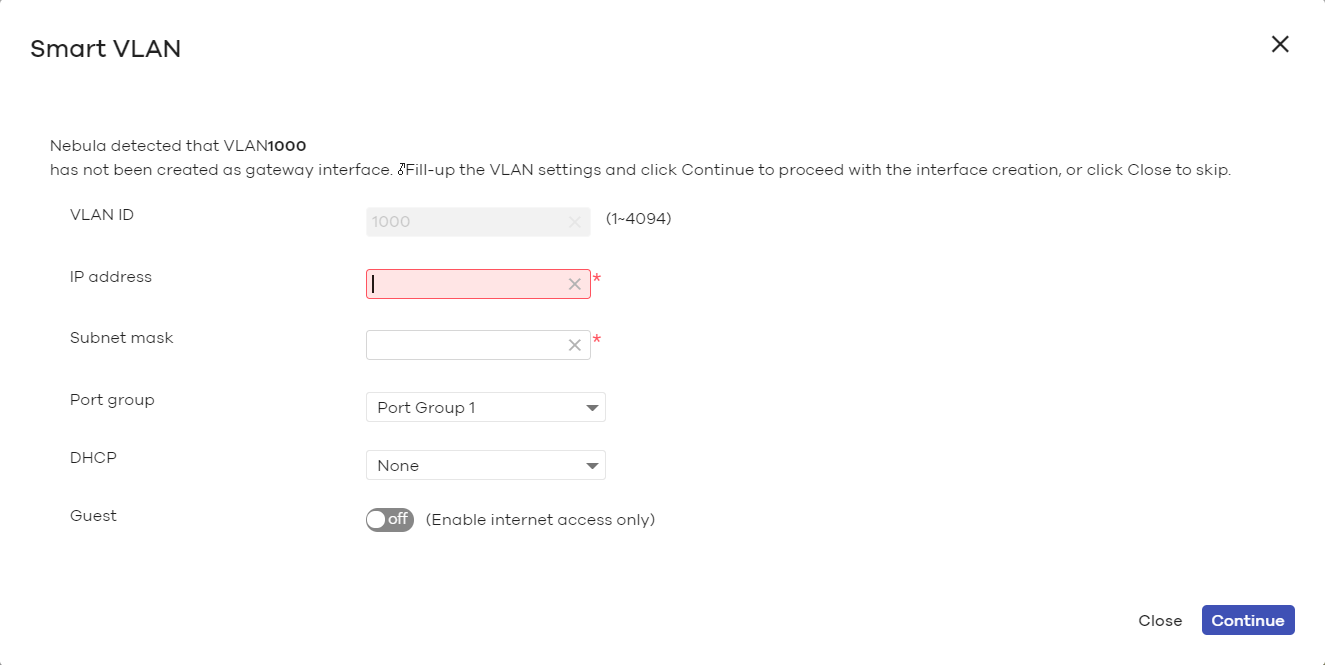 |
Band mode | Select to have the SSID use either 2.4GHz band, 5GHz band, or 6GHz band only. |
Layer 2 isolation | This field is not configurable if you select NAT mode. Select to turn on or off layer-2 isolation. If a device’s MAC addresses is NOT listed, it is blocked from communicating with other devices in an SSID on which layer-2 isolation is enabled. Click Add to enter the MAC address of each device that you want to allow to be accessed by other devices in the SSID on which layer-2 isolation is enabled. |
Intra-BSS traffic blocking | Select on to prevent crossover traffic from within the same SSID. Select off to allow intra-BSS traffic. |
Band select | Select to enable band steering. When enabled, the Nebula Device steers WiFi clients to the 5 GHz band. |
Assisted roaming | Select to turn on or off IEEE 802.11k/v assisted roaming on the Nebula Device. When the connected clients request 802.11k neighbor lists, the Nebula Device will response with a list of neighbor Nebula Devices that can be candidates for roaming. When the 802.11v capable clients are using the 2.4 GHz band, the Nebula Device can send 802.11v messages to steer clients to the 5 GHz band. |
802.11r | Select to turn on or off IEEE 802.11r fast roaming on the Nebula Device. 802.11r fast roaming reduces the delay when the clients switch from one Nebula Device to another, by allowing security keys to be stored on all Nebula Devices in a network. Information from the original association is passed to the new Nebula Device when the client roams. The client does not need to perform the whole 802.1x authentication process. |
U-APSD | Select to turn on or off Automatic Power Save Delivery. This helps increase battery life for battery-powered WiFi clients connected to the Nebula Device. |
Captive Portal Customization
Use this screen to configure captive portal settings for SSID profiles. A captive portal intercepts network traffic until the user authenticates his or her connection, usually through a specifically designated login web page.
Click Access Point > Configure > Captive portal customization to access this screen.
Access Point > Configure > Captive portal customization

The following table describes the labels in this screen.
Label | Description |
|---|---|
SSID | Select the SSID profile to which the settings you configure here is applied. |
Themes | This section is not configurable when External captive portal URL is set to ON. • Click the Preview icon at the upper right of a theme image to display the portal page in a new frame. • Click the Copy icon to create a new custom theme (login page). • Click the Edit icon of a custom theme to go to a screen where you can view and configure the details of the custom theme pages. See Custom Theme Edit. • Click the Remove icon to delete a custom theme page. Select the theme you want to use on the specified SSID. |
Click-to-continue/Voucher/Sign-on page This section is not configurable when External captive portal URL is set to ON. | |
Logo | This shows the logo image that you uploaded for the customized login page. Click Upload a logo and specify the location and file name of the logo graphic or click Browse to locate it. You can use the following image file formats: GIF, PNG, or JPG. |
Message | Enter a note to display below the title. Use up to 1024 printable ASCII characters. Spaces are allowed. |
Success page | |
Message | Enter a note to display on the page that displays when a user logs in successfully. Use up to 1024 printable ASCII characters. Spaces are allowed. |
External captive portal URL | |
Use URL | Select On to use a custom login page from an external web portal instead of the one built into the NCC. You can configure the look and feel of the web portal page. Specify the login page’s URL; for example, http://IIS server IP Address/login.asp. The Internet Information Server (IIS) is the web server on which the web portal files are installed. Click Download to download a ZIP file containing example captive port files. Edit these files then upload them to a webserver which is accessible from NCC.  |
Captive portal behavior | |
After the captive portal page where the user should go? | Select To promotion URL and specify the URL of the web site or page to which the user is redirected after a successful login. Otherwise, select Stay on Captive portal authenticated successfully page. |
Custom Theme Edit
Use this screen to check what the custom portal pages look like. You can also view and modify the CSS values of the selected HTML file. Click a custom login page’s Edit button in the Access Point > Configure > Captive portal screen to access this screen.
Access Point > Configure > Captive portal: Edit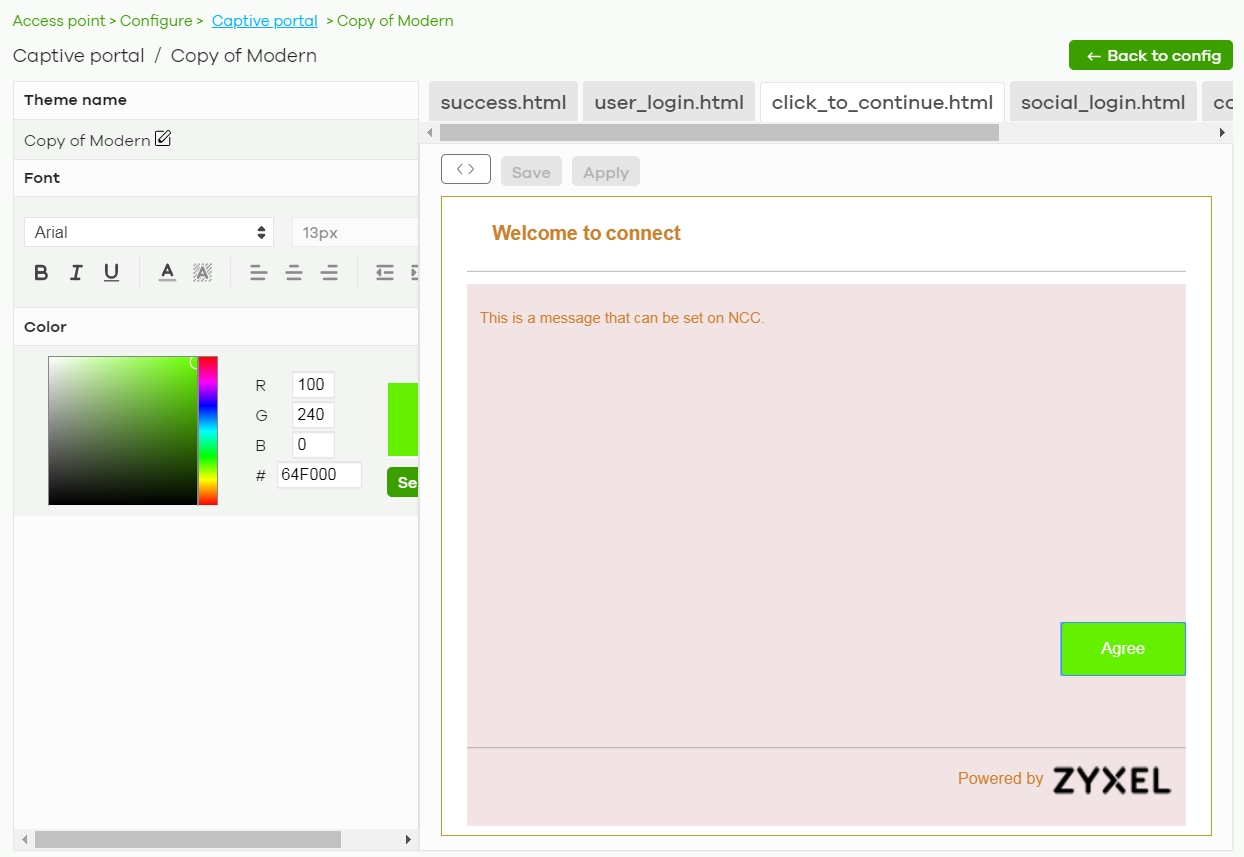

The following table describes the labels in this screen.
Label | Description |
|---|---|
Back to config | Click this button to return to the Captive portal screen. |
Theme name | This shows the name of the theme. Click the edit icon the change it. |
Font | Click the arrow to hide or display the configuration fields. To display this section and customize the font type and/or size, click on an item with text in the preview of the selected custom portal page (HTML file). |
Color | Click the arrow to hide or display the configuration fields. Click an item in the preview of the selected custom portal page (HTML file) to customize its color, such as the color of the button, text, window’s background, links, borders, and so on. Select a color that you want to use and click the Select button. |
HTML/CSS | This shows the HTML file name of the portal page created for the selected custom theme. This also shows the name of the CSS files created for the selected custom theme. Click a HTML file to display the portal page. You can also change colors and modify the CSS values of the selected HTML file. |
Click this button to view and modify the CSS values of the selected HTML file. It is recommended that you do NOT change the script code to ensure proper operation of the portal page. | |
Click this button to preview the portal page (the selected HTML file). | |
Save | Click this button to save your settings for the selected HTML file to the NCC. |
Apply | Click this button to save your settings for the selected HTML file to the NCC and apply them to the access points in the site. |
SSID Availability
Use this screen to configure SSID availability and the schedules which can be applied to the SSIDs. The SSID is enabled or disabled at the specified time. Click Access Point > Configure > SSID availability to access this screen.
Access Point > Configure > SSID availability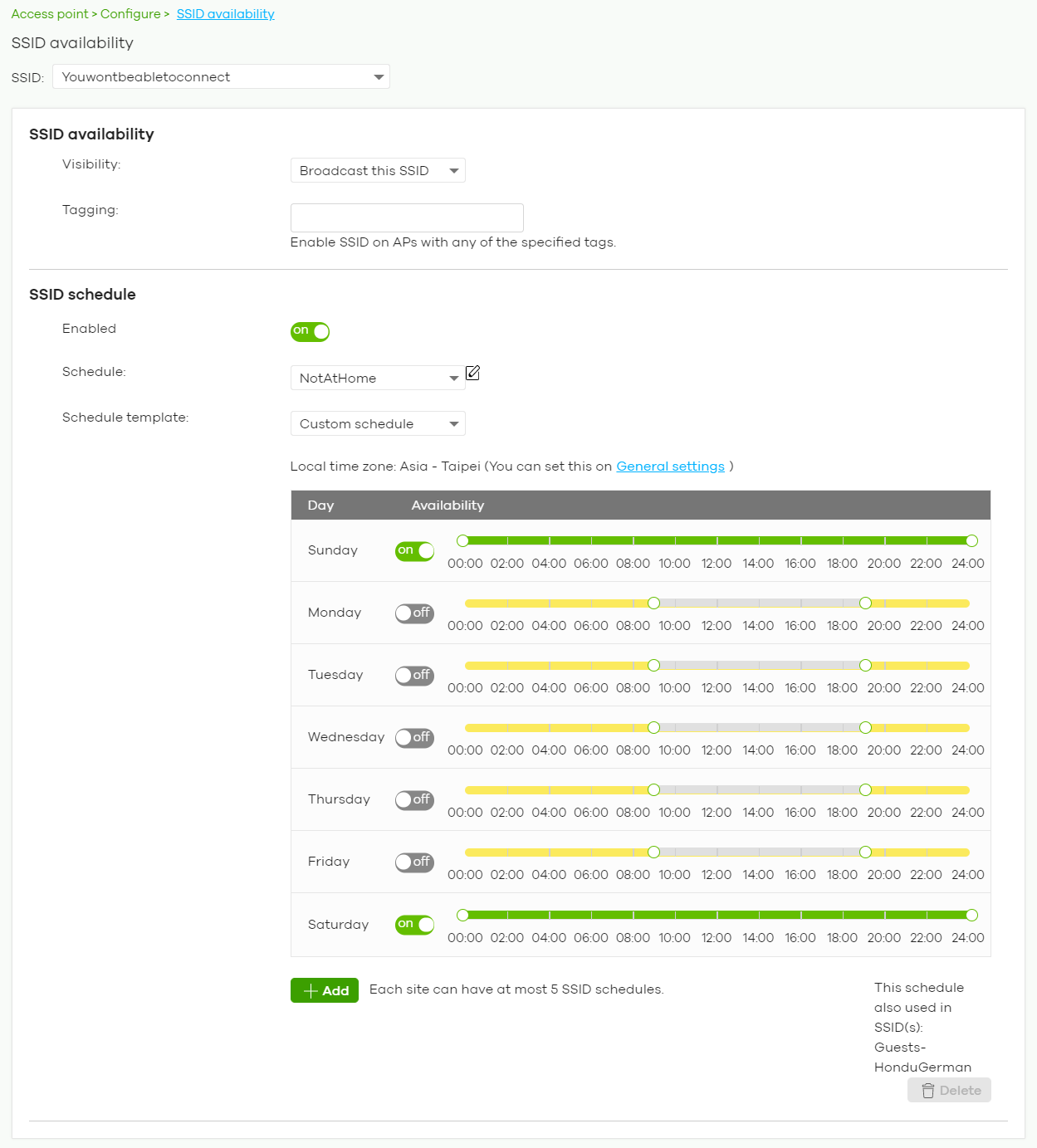

The following table describes the labels in this screen.
Label | Description |
|---|---|
SSID | Select the SSID profile to which the settings you configure here is applied. |
SSID availability | |
Visibility | Select Hide this SSID if you want to hide your SSID from WiFi clients. This tells any WiFi clients in the vicinity of the Nebula Device using this SSID profile not to display its SSID name as a potential connection. Not all WiFi clients respect this flag and display it anyway. Otherwise, select Broadcast this SSID. When an SSID is “hidden” and a WiFi client cannot see it, the only way you can connect to the SSID is by manually entering the SSID name in your WiFi connection setup screens (these vary by client, client connectivity software, and operating system). |
Tagging | Enter the tags you created for Nebula Devices in the Access Point > Monitor > Access Points screen. The SSID profile will only be applied to Nebula Devices with the specified tag. If you leave this field blank, this SSID profile will be applied to all Nebula Devices in the site. |
SSID schedule | |
Enabled | Click On to enable and configure a schedule. |
Schedule | Select a schedule to control when the SSID is enabled or disabled. You can click the edit icon to change the schedule name. |
Schedule templates | Select a pre-defined schedule template or select Custom schedule and manually configure the day and time at which the SSID is enabled or disabled. |
Day | This shows the day of the week. |
Availability | Click On to enable the SSID at the specified time on this day. Otherwise, select Off to disable the SSID on the day and at the specified time. Specify the hour and minute when the schedule begins and ends each day. |
Add | Click this button to create a new schedule. A window pops up asking you to enter a descriptive name for the schedule for identification purposes. 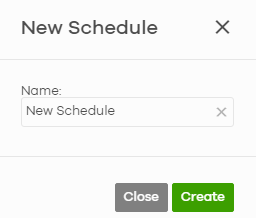 |
Delete | Click this button to remove a schedule which is not used in any SSID profile. |
Radio Settings
Use this screen to configure global radio settings for all Nebula Devices in the site. Click Access Point > Configure > Radio settings to access this screen.
Access Point > Configure > Radio settings


The following table describes the labels in this screen.
Label | Description |
|---|---|
Country | Select the country where the Nebula Device is located or installed. The available channels vary depending on the country you selected. Be sure to select the correct or same country for both radios on a Nebula Device and all connected Nebula Devices in order to prevent roaming failure and interference with other systems. |
Deployment selection | Select High-density (More than 10 APs) for the lowest output power for 10 or more Access Points. Select Moderate-density (6-9 APs) for moderate output power for 5 to 9 Access Points. Select Low-density (2-5 APs) for higher concentration of output power for less than 5 Access Points. Select Single AP for highest concentration of output power for a single Access Point. |
Maximum output power | Selecting any of the options in the Deployment selection field will automatically set the maximum output power for 2.4 / 5 / 6 GHz. But you can change the setting (1 – 30 dBm). |
Channel width | Select the wireless channel bandwidth you want the access point to use. A standard 20 MHz channel offers transfer speeds of up to 144 Mbps (2.4 GHz) or 217 Mbps (5 GHz) whereas a 40 MHz channel uses two standard channels and offers speeds of up to 300 Mbps (2.4 GHz) or 450 Mbps (5 GHz). An IEEE 802.11ac-specific 80 MHz channel offers speeds of up to 1.3 Gbps. 40 MHz (channel bonding or dual channel) bonds two adjacent radio channels to increase throughput. An 80 MHz channel consists of two adjacent 40 MHz channels. The WiFi clients must also support 40 MHz or 80 MHz. It is often better to use the 20 MHz setting in a location where the environment hinders the WiFi signal. |
DCS setting | |
DCS time interval | Select ON to set the DCS time interval (in minutes) to regulate how often the Nebula Device surveys the other Nebula Devices within its broadcast radius. If the channel on which it is currently broadcasting suddenly comes into use by another Nebula Device, the Nebula Device will then dynamically select the next available clean channel or a channel with lower interference. |
DCS schedule | Select ON to have the Nebula Device automatically find a less-used channel within its broadcast radius at a specific time on selected days of the week. You then need to select each day of the week and specify the time of the day (in 24-hour format) to have the Nebula Device use DCS to automatically scan and find a less-used channel. |
DCS client aware | Select ON to have the Nebula Device wait until all connected clients have disconnected before switching channels. |
Avoid 5G DFS channel | If your Nebula Devices are operating in an area known to have RADAR devices, the Nebula Device will choose non-DFS channels to provide a stable WiFi service. |
Blacklist DFS channels in the presence of radar | Select ON to blacklist a channel if RADAR is detected. After being blacklisted, the Nebula Device will not use the channel again until the Nebula Device is rebooted. However, the Nebula Device can still use other DFS channels. |
2.4 GHz channel deployment | Select Three-Channel Deployment to limit channel switching to channels 1, 6, and 11, the three channels that are sufficiently attenuated to have almost no impact on one another. In other words, this allows you to minimize channel interference by limiting channel-hopping to these three “safe” channels. Select Four-Channel Deployment to limit channel switching to four channels. Depending on the country domain, if the only allowable channels are 1 – 11 then the Nebula Device uses channels 1, 4, 7, 11 in this configuration; otherwise, the Nebula Device uses channels 1, 5, 9, 13 in this configuration. Four channel deployment expands your pool of possible channels while keeping the channel interference to a minimum. Select All available channels to allow channel-hopping to have the Nebula Device automatically select the best channel. Select Manual to select the individual channels the Nebula Device switches between. |
5 GHz channel deployment | Select how you want to specify the channels the Nebula Device switches between for 5 GHz operation. Select All available channels to have the Nebula Device automatically select the best channel. Select Manual to select the individual channels the Nebula Device switches between. |
6 GHz channel deployment | Select how you want to specify the channels the Nebula Device switches between for 6 GHz operation. Select All available channels to have the Nebula Device automatically select the best channel. Select Manual to select the individual channels the Nebula Device switches between. |
Allow 802.11ax/ac/n stations only | Select ON to have the Nebula Device allow only IEEE 802.11n/ac/ax clients to connect, and reject IEEE 802.11a/b/g clients. |
Smart Steering | Select ON to enable smart client steering on the Nebula Device. Client steering helps monitor WiFi clients and drop their connections to optimize the bandwidth when the clients are idle or have a low signal. When a WiFi client is dropped they have the opportunity to steer to an Nebula Device with a strong signal. Additionally, dual band WiFi clients can also steer from one band to another. Select OFF to disable this feature on the Nebula Device. |
ADVANCED OPTIONS | Click this to display a greater or lesser number of configuration fields. |
2.4G/5G/6G Setting | |
Disassociate Station Threshold | Set a minimum kick-off signal strength. When a WiFi client’s signal strength is lower than the specified threshold, the Nebula Device disconnects the WiFi client. –20 dBm is the strongest signal you can require and –105 dBm is the weakest. |
Optimization aggressiveness | High, Standard and Low stand for different traffic rate threshold levels. The level you select here decides when the Nebula Device takes action to improve the access point’s WiFi network performance. The Nebula Device will postpone the actions implemented on access points until your network is less busy if the threshold is exceeded. Select a suitable traffic rate threshold level for your network. High: Select this if you want the Nebula Device to postpone the action set when the access point network traffic is heavy. Standard: Select this if you want the Nebula Device to postpone the action set when the access point network traffic is medium. Low: Select this if you want the Nebula Device to postpone the action set when the access point network traffic is low. |
802.11d | Click this to enable 802.11d on the access point. 802.11d is a WiFi network specification, for use in countries where 802.11 WiFi is restricted. Enabling 802.11d causes the Nebula Device to broadcast the country where it is located, which is determined by the Country setting. |
WLAN Rate Control Setting | |
2.4Ghz/5Ghz/6Ghz | Sets the minimum data rate that 2.4 GHz, 5 GHz, and 6 GHz WiFi clients can connect to the Nebula Device, in Mbps. Increasing the minimum data rate can reduce network overhead and improve WiFi network performance in high density environments. However, WiFi clients that do not support the minimum data rate will not be able to connect to the Nebula Device. |
Edit | Click this button to modify the channel, output power, channel width, airtime fairness (the same setting will apply to both 2.4 GHz and 5 GHz), and smart steering settings for the selected Nebula Devices. On the Nebula Device that comes with internal antennas and also has an antenna switch, you can adjust coverage depending on the orientation of the antenna for the Nebula Device radios. Select Wall if you mount the Nebula Device to a wall. Select Ceiling if the Nebula Device is mounted on a ceiling. You can switch from Wall to Ceiling if there are still WiFi dead zones, and so on. If you select Hardware Switch, you use the physical antenna switch to adjust coverage and apply the same antenna orientation settings to both radios. |
DCS Now | Click this button to have the selected Nebula Devices immediately scan for and select a channel that has least interference. |
List | Click this to display a list of all connected Nebula Devices. |
Map | Click this to display the locations of all connected Nebula Devices on the Google map. |
2.4GHz | Click this to display the connected Nebula Devices using the 2.4 GHz frequency band. |
5GHz | Click this to display the connected Nebula Devices using the 5 GHz frequency band. |
6GHz | Click this to display the connected Nebula Devices using the 6 GHz frequency band. |
BandFlex | Click this to display the connected Nebula Devices that supports BandFlex (5 GHz or 6 GHz frequency bands). |
Hide transmit circles | Click this button to not show the transmission range on the Map. |
Access point | This displays the descriptive name or MAC address of the connected Nebula Device. |
Radio # | This displays the number of the connected Nebula Device’s radio. |
Model | This displays the model name of the connected Nebula Device. |
Radio mode | This displays the type of WiFi radio the Nebula Device is currently using, for example 802.11b/g/n. |
Channel | This displays the channel ID currently being used by the connected Nebula Device’s radio. |
Transmit power | This displays the current transmitting power of the connected Nebula Device’s radio. If the Nebula Device is offline, this shows the maximum output power you configured for the Nebula Device. |
Channel width | This displays the wireless channel bandwidth the connected Nebula Device’s radio is set to use. |
Smart steering | This displays whether smart client steering is enabled or disabled on the connected Nebula Devices. |
Antenna | This displays the antenna orientation settings for the Nebula Device that comes with internal antennas and also has an antenna switch. |
Airtime fairness | This displays whether airtime fairness is enabled or disabled on the connected Nebula Device. |
Click this icon to display a greater or lesser number of configuration fields. For faster loading of data, select only the configuration fields listed that do NOT take a long time to fetch data. | |
The following table describes the pre-defined deployments and the related output power, channel width, DFS (Dynamic Frequency Selection) setting, rate control, and channel deployment.
deployment | high density | moderate density | low density | single ap | |
|---|---|---|---|---|---|
Number of APs | More than 10 | 6 – 9 | 2 – 5 | 1 | |
Power (dBm) | 2G | 12 | 15 | 20 | 30 20 (EU) |
5G | 15 | 18 | 30 | 30 | |
6G | 18 | 21 | 30 | 30 | |
Channel width (MHz) | 5G | 20 | 40 | 80 | 80 |
6G | 80 | 160 | 160 | 160 | |
Avoid 5G DFS channel / Blacklist DFS channels in the presence of radar | Disabled / Enabled | Enabled /Disabled | Enabled / Disabled | Enabled / Disabled | |
Rate control (Mbps) | 2.4G | 11 | 1 | 1 | 1 |
5G | 12 | 6 | 6 | 6 | |
2.4G channel deployment | All channels | Three-channel | Three-channel | Three-channel | |
Traffic Shaping
This feature is for dynamic VLAN application. The data limit set here applies to the VLAN on a per WiFi client basis. This has a higher priority than the data limit set in Access Point > Configure > SSID advanced settings, which is applied on a per station basis. Use this screen to configure maximum bandwidth on the Nebula Device.
Click Access point > Configure > Traffic shaping to access this screen.
Access point > Configure > Traffic shaping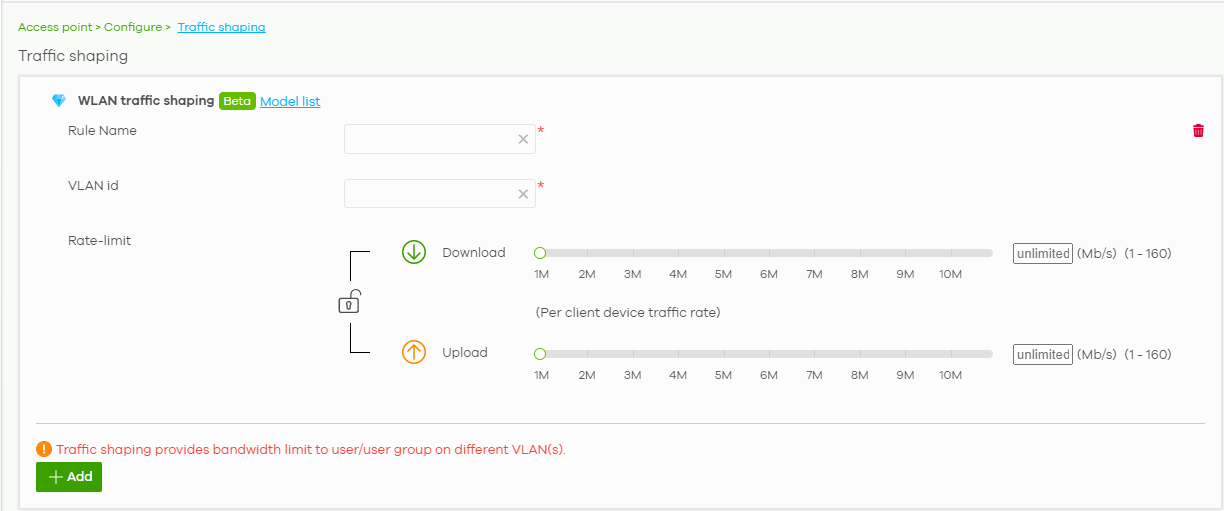

The following table describes the labels in this screen.
Label | Description |
|---|---|
WLAN traffic shaping | |
Rule Name | Enter the name of the traffic shaping rule. The name is used to refer to the traffic shaping rule. You may use 1 – 31 alphanumeric characters, underscores(_), or dashes (-). This value is case-sensitive. |
VLAN ID | Enter the VLAN ID. This 12-bit number uniquely identifies each VLAN. Allowed values are 1 – 4094. (0 and 4095 are reserved.) |
Rate-limit | Set the maximum data download and upload rate in Mb/s, on a per WiFi client basis. Allowed values are 1 – 160. Click the lock icon to change the lock state. If the lock icon is locked, the data limit you set applies to both download and upload traffic. If the lock is unlocked, you can set download and upload traffic to have different data limits. |
Add | Click this button to create a new rule. |
Security Service
Use this screen to enable or disable the features available in the security pack for your Nebula Device, such as application visibility and optimization and/or IP reputation filter.
Click Access Point > Configure > Security service to access this screen.
Access Point > Configure > Security service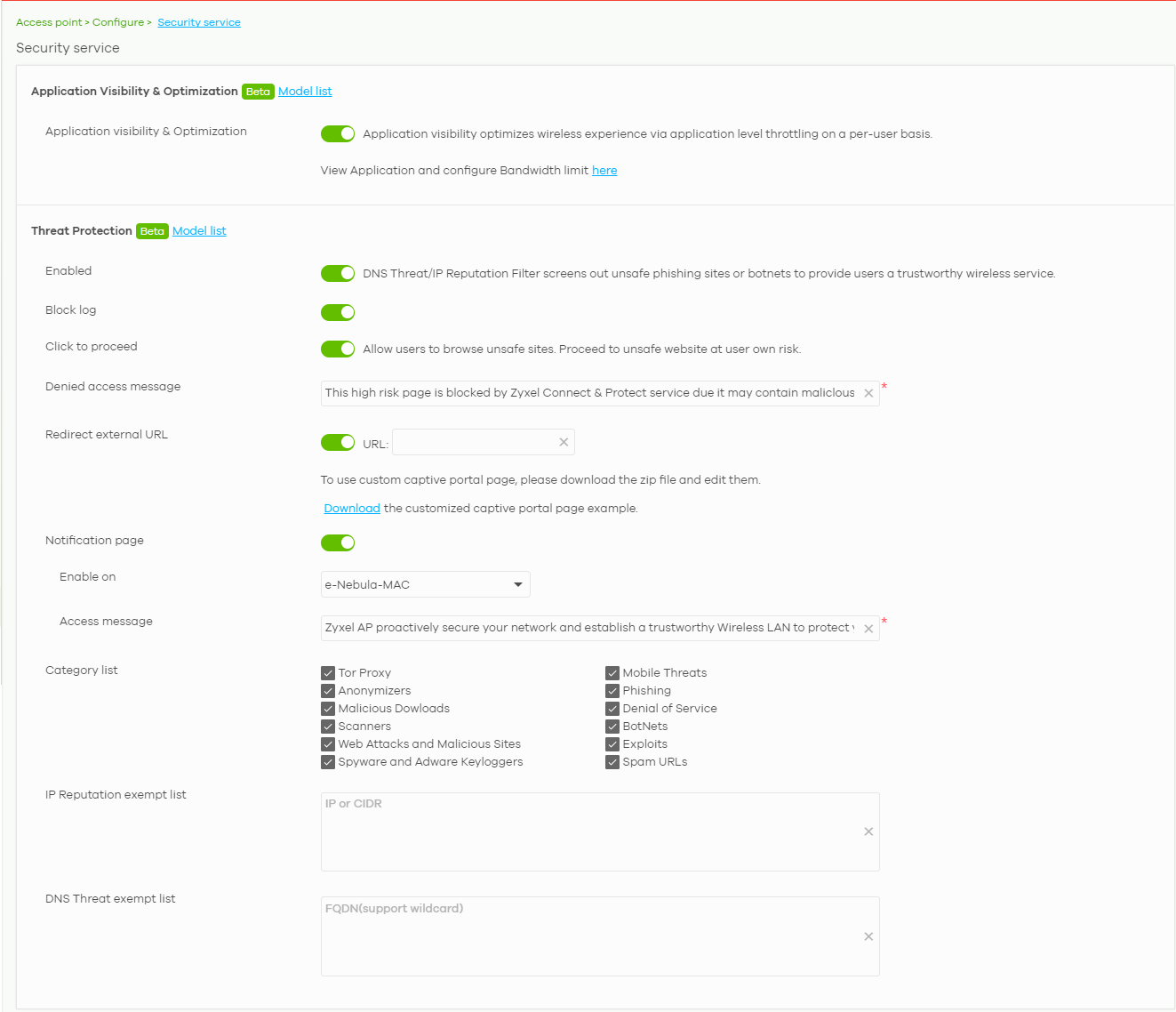

The following table describes the labels in this screen.
Label | Description |
|---|---|
Application Visibility & Optimization | |
Application visibility & Optimization | Select this option to turn on application visibility and optimization. Application visibility and optimization does the following: • Detects the type of applications used by WiFi clients, • Throttles specific applications to save WiFi bandwidth. Application visibility provides a way for a Nebula Device to manage the use of various applications on its WiFi network. It can detect the type of applications used by WiFi clients and how much bandwidth they use. Application optimization limits the applications bandwidth usage by their categories. You can manage and view the applications and their categories in Site-wide > Monitor > Applications > Application view by Access Point. |
Threat Protection | |
Enabled | Select this option to allow inspection of DNS queries made by clients on your network and turn on IP blocking on the Nebula Device. When you enable the DNS threat service, your Nebula Device inspects the DNS queries against a database of blocked or allowed Fully Qualified Domain Names (FQDNs). You can have the Nebula Device reply to the user with a fake DNS response (where the user will see a “Web Page Blocked!” page). When you enable the IP reputation service, your Nebula Device downloads signature files that identifies reputation of IPv4 addresses. You can have the Nebula Device forward, block, and/or log packets from IPv4 addresses based on these signatures and categories. |
Block log | Select this option to create a log on the Nebula Device when the packet comes from an IPv4 address with bad reputation. |
Click to proceed | Select this option to allow clients to browse unsafe websites. When enabled, the denied access message window includes the Proceed button. To continue, you must close and restart your web browser to visit the unsafe website.  |
Denied access message | Enter a message to be displayed when IP reputation filter blocks access to a web page. Use up to 127 characters (0–9a–zA–Z;/?:@&=+$\.-_!~*'()%,”). For example, “Access to this web page is not allowed. Please contact the network administrator”. It is also possible to leave this field blank if you have a URL specified in the Redirect external URL field. In this case if the IP reputation filter blocks access to a web page, the Nebula Device just opens the web page you specified without showing a denied access message. |
Redirect external URL | Enter the URL of the web page to which you want to send users when their web access is blocked by IP reputation filter. The web page you specify here opens in a new frame below the denied access message. Use “http://” or “https://” followed by up to 262 characters (0–9a–zA–Z;/?:@&=+$\.-_!~*'()%). For example, http://192.168.1.17/blocked access. |
Notification page | Select this option to display the notification page. |
Enable on | Select the SSID 1 – 8 that is allowed access to WiFi clients. |
Access message | Enter a message to be displayed when access to a web page is allowed. Use up to 127 characters (0–9a–zA–Z;/?:@&=+$\.-_!~*'()%,”). For example, “Access to this web page is not allowed. Please contact the network administrator”. |
Category list | Select the categories of packets that come from the Internet and are known to pose a security threat to users or their computers. |
IP Reputation exempt list | Sites that you want to allow access to, regardless of their content rating, can be allowed by adding them to this list. Add the IPv4 addresses that the Nebula Device will allow the incoming and outgoing packets. |
DNS Threat exempt list | Domain names that you want to allow access to, regardless of their reputation, can be allowed by adding them to this list. Add the Fully Qualified Domain Names (FQDNs) that the Nebula Device will allow the DNS query packets. |
AP & Port Settings
Use this screen to configure general Nebula Device settings and network traffic load balancing between the Nebula Devices in the site. This screen also allows you to enable or disable a port on the managed Nebula Device and configure the port’s VLAN settings. The port settings apply to all Nebula Devices that are assigned to the site and have one or more than one Ethernet LAN port (except the uplink port).
Click Access Point > Configure > AP & port settings to access this screen.
Access Point > Configure > AP & port settings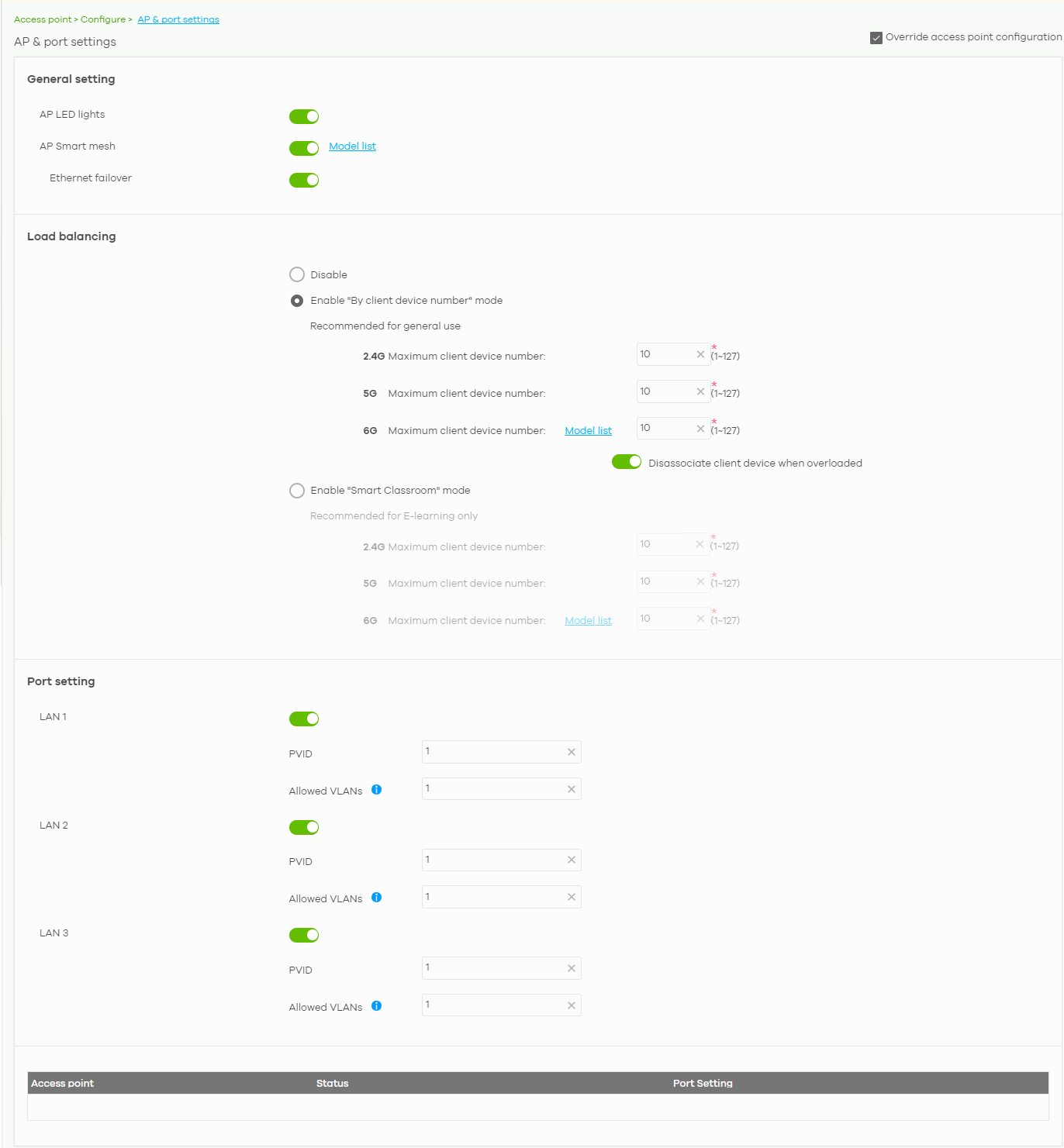

The following table describes the labels in this screen.
Label | Description |
|---|---|
General setting | |
AP LED lights | Click to turn on or off the LEDs on the Nebula Devices. |
AP Smart Mesh | Click to enable or disable the Nebula Smart Mesh feature on all Nebula Devices in the site. Click Model list to see whether your Nebula Device supports Nebula Smart Mesh. |
Ethernet failover | When enabled, a wired Nebula Device in the site automatically changes its role from mesh controller to mesh extender if the Nebula Device is unable to reach the site’s gateway. When disabled, a wired Nebula Device in the site automatically changes its role from mesh controller to mesh extender only if the Nebula Device’s uplink Ethernet cable is unplugged. |
Load balancing | |
Disable | Select this option to disable load balancing on the Nebula Device. |
Enable "By client device number" mode | Select this option to balance network traffic based on the number of specified client devices connected to the Nebula Device. |
Maximum client device number | Enter the threshold number of client devices at which the Nebula Device begins load balancing its connections. |
Disassociate client device when overloaded | Select ON to disassociate WiFi clients connected to the Nebula Device when it becomes overloaded. Select OFF to disable this option, then the Nebula Device simply delays the connection until it can afford the bandwidth it requires, or it transfers the connection to another Nebula Device within its broadcast radius. The disassociation priority is determined automatically by the Nebula Device and is as follows: • Idle Time – Devices that have been idle the longest will be disassociated first. If none of the connected devices are idle, then the priority shifts to Signal Strength. • Signal Strength – Devices with the weakest signal strength will be disassociated first. |
Enable "Smart Classroom" mode | Select this option to balance network traffic based on the number of specified client devices connected to the Nebula Device. The Nebula Device ignores association request and authentication request packets from any new client device when the maximum number of client devices is reached. The Disassociate client device when overloaded function is enabled by default and the disassociation priority is always Signal Strength when you select this option. |
Maximum client device number | Enter the threshold number of client devices at which the Nebula Device begins load balancing its connections. |
Port setting | |
LAN x | This is the name of the physical Ethernet port on the Nebula Device. This section lets you configure global port VLAN settings for all Nebula Devices in the site. To modify port settings for a specific Nebula Device, use its Edit button in the table below. |
ON/OFF | Select ON to turn on the LAN port of the Nebula Device. Select OFF to disable the port. |
PVID | Enter the port’s PVID. A PVID (Port VLAN ID) is a tag that adds to incoming untagged frames received on a port so that the frames are forwarded to the VLAN group that the tag defines. |
Allowed VLANs | Enter the VLAN ID numbers to which the port belongs. You can enter individual VLAN ID numbers separated by a comma or a range of VLANs by using a dash, such as 1,3,5–8. |
Access Point | This displays the descriptive name or MAC address of the connected Nebula Device. Only the Nebula Device that has an extra Ethernet LAN port will be listed, such as NAP203 or NAP303. |
Status | This shows whether the Nebula Device’s Ethernet LAN port is enabled or disabled. |
Port Setting | This displays the port’s VLAN settings for the managed Nebula Device. |
Edit Port Settings
Click an entry in the Port setting table of the Access Point > Configure > AP & port settings screen to access this screen.
Select NAT mode to have the Nebula Device create a DHCP subnet with its own NAT for the SSID. This simplifies WiFi network management, as you do not need to configure a separate DHCP server. Otherwise, select Local bridge.
The following Nebula Device features do not work when NAT mode is enabled:
• 802.11r (see Access Point > Configure > SSID advanced settings for more information on enabling 802.11r)
• Layer2 isolation
• Dynamic VLAN (cloud authentication, RADIUS server)
Only WAC500H supports Ethernet Traffic options Forwarding Mode at the time of writing.
By default, all Nebula Devices in the site use the global port settings. Use this screen to change the port settings on a per-device basis. You can turn on or off the port, modify its PVID or update the ID number of VLANs to which the port belongs.
Access Point > Configure > AP & port settings: Edit